HOW THE UNION LEAGUE INVESTS IN ITS CHEFS

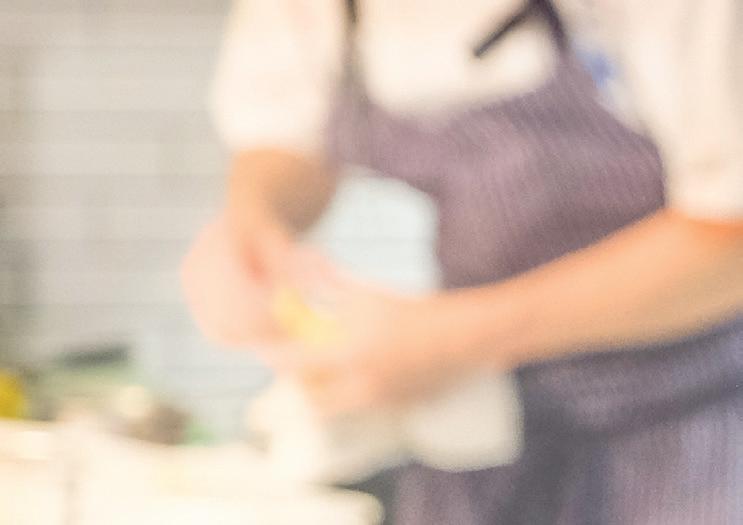
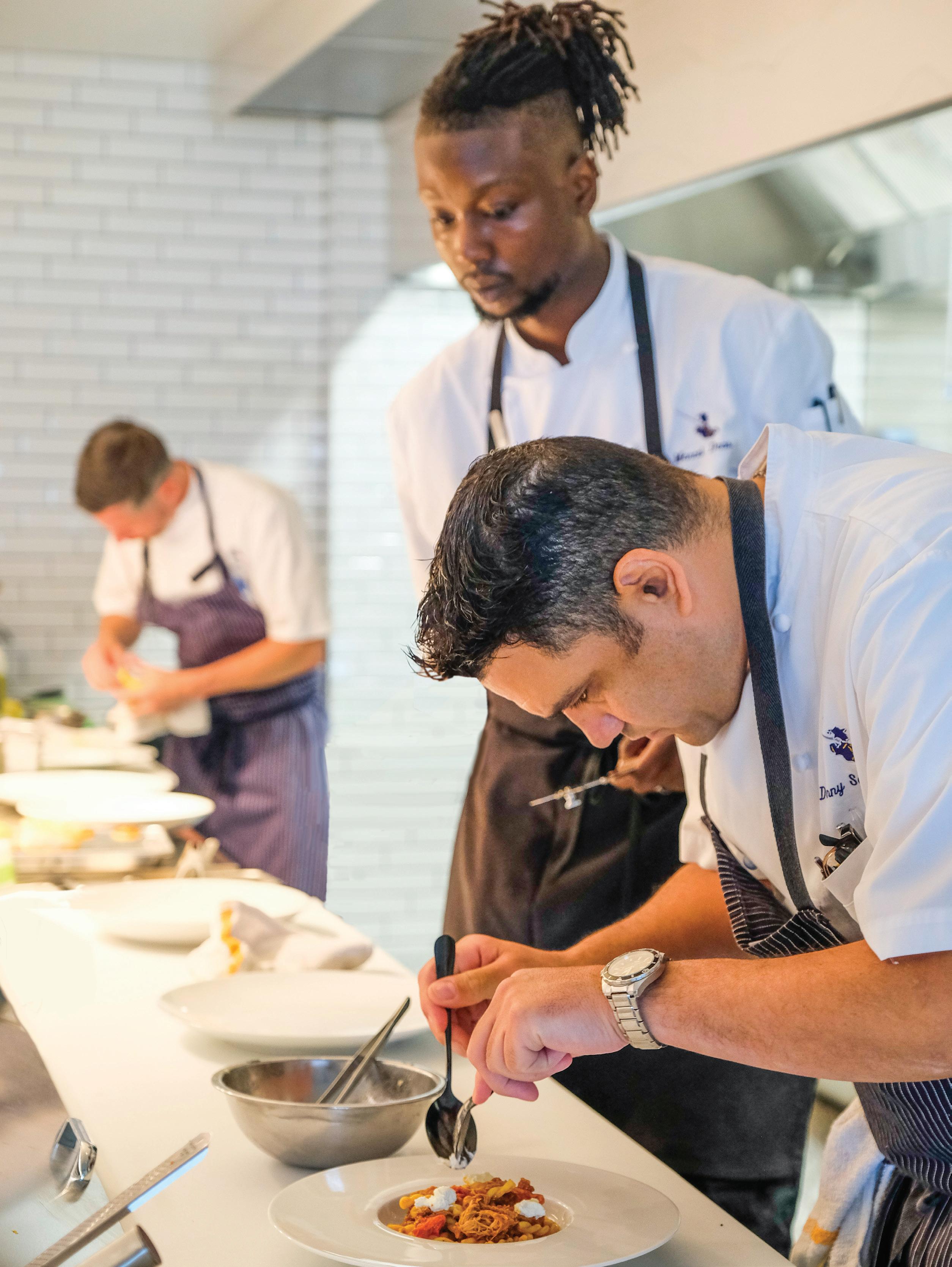
As The Union League of Philadelphia celebrates the first anniversary of Marquis by Denny Santiago, the restaurant’s namesake continues a decades-long legacy of mentorship and culinary excellence.


INSIDE


Charcuterie That Goes Beyond the Board
Small Bites Bring Big Delights

The Decline of Member Etiquette





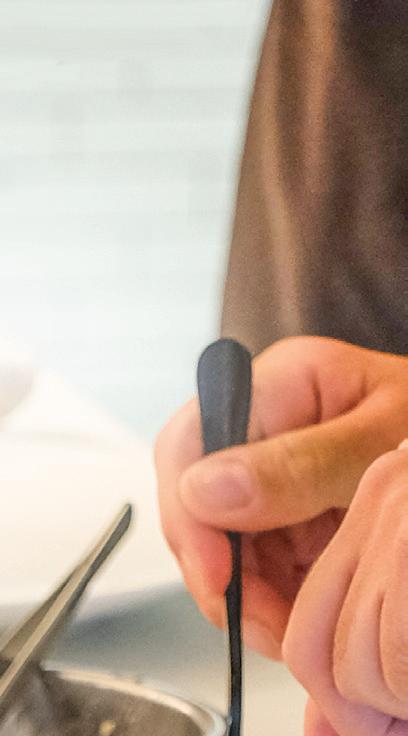







September 2023 www.clubandresortchef.com
A REVOLUTION AND A GREAT PARTNER
CONNECTIONS AND FRIENDSHIPS often serve as the catalyst for innovation and progress.
I met Scott Craig, WCMC, Executive Chef of Cullasaja Club (Highlands, N.C.), during a dinner at New Orleans Country Club almost a decade ago. Little did I know that this random seating arrangement would lead to a profound partnership, one that has greatly enriched Club + Resort Chef
Over the years, Chef Craig has proven to be a valuable ally, consistently offering his time and expertise. His bold ideas—sometimes appearing out of thin air— have stretched the limits of our capabilities, challenging us to rise to the occasion. But as I have learned, when Chef Craig proposes an idea, it’s because the industry needs it, and we must heed the call.
One such example is our salary survey. If you haven’t had the opportunity to participate yet, I encourage you to access it via the QR code provided near my signature. This survey aims to shed light on the salaries and compensation packages of chefs and culinary professionals in club and resort settings, promoting transparency and fair compensation practices. The results, which will be unveiled in our November issue, are already shaping up to be a valuable resource for our industry, thanks to the participation of over 400 chefs.

This collaborative, innovative spirit doesn’t stop there.
As the Chef to Chef Conference has continued to grow, the aspiration for something smaller, more focused, and hands-on always lingered in the back of my mind. But the logistics remained elusive—until Chef Craig stepped in.
Together, we conceived PlateCraft, a distinctive and immersive two-day culinary experience that will unfold at Cullasaja Club from November 5th to 7th, 2023. With limited seats available, PlateCraft
promises an exclusive opportunity for chefs to delve deeper into their craft, to collaborate, learn, and elevate their culinary expertise.
The response to PlateCraft has been nothing short of remarkable. When we opened registration on August 21st, it took a mere six days for all available seats to be claimed, a testament to the hunger for such unique and enriching experiences within the club culinary community.
Thanks to chefs like Chef Craig who share our commitment to advancing club culinary, I am excited to see PlateCraft come to life and look forward to the impact it will undoubtedly have on the industry.
However, let me be clear: This is just the beginning of our journey. As we continue to shape fresh content, conceive innovative events, and incubate novel ideas, partners like Chef Craig, and indeed, all of you, are paramount to ensuring our mission remains pertinent and beneficial.
Together, we are not only preserving the rich tapestry of club culinary but weaving new threads that will inspire, educate, and elevate the entire industry.
DIRECTOR OF EDITORIAL AND PROGRAMMING


 Joanna DeChellis jdechellis@wtwhmedia.com 412-260-9233
Joanna DeChellis jdechellis@wtwhmedia.com 412-260-9233


2 l Club + Resort Chef l September 2023 www.clubandresortchef.com EDITOR’S MEMO
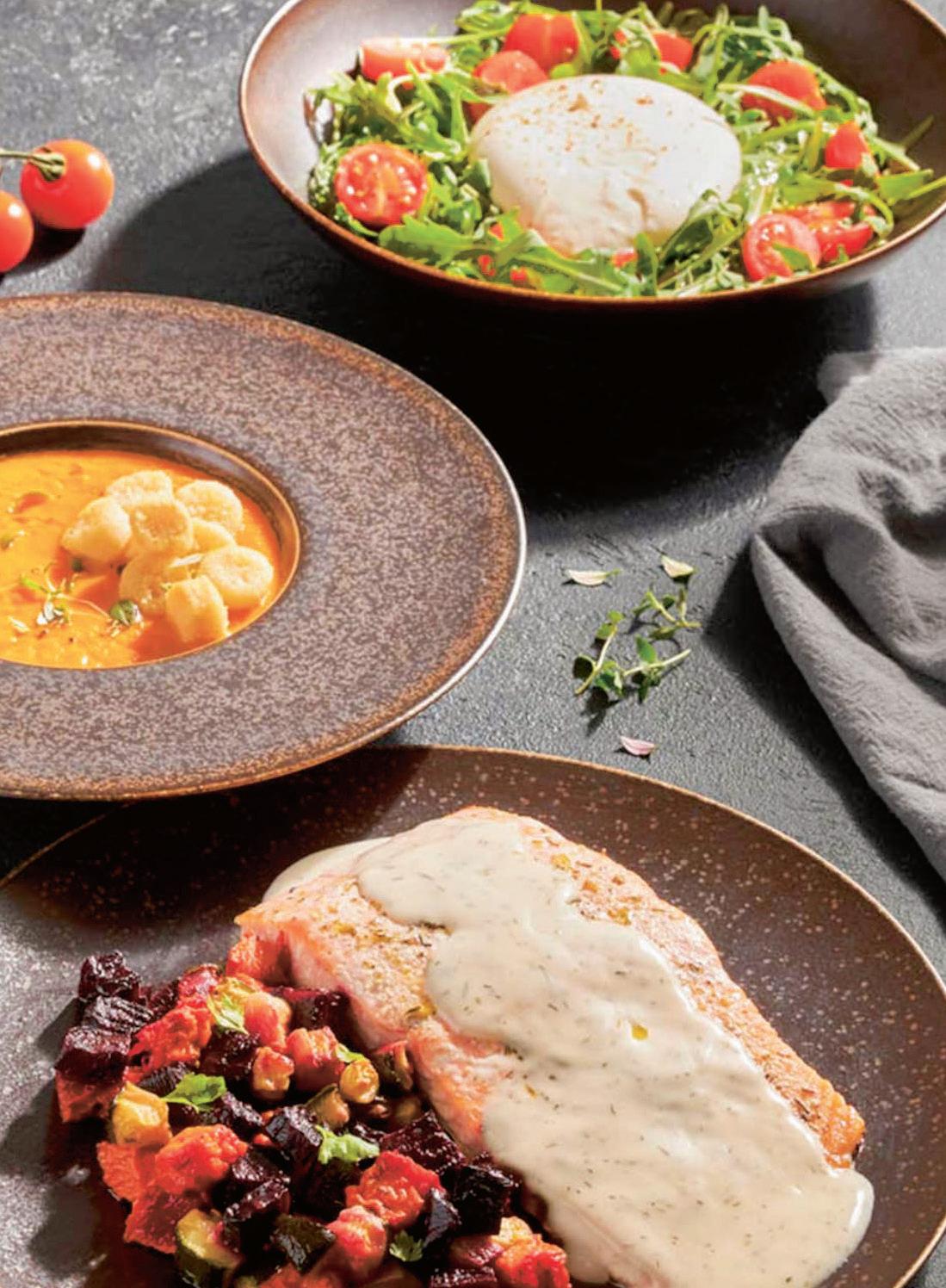

www.corbyhall.com
Patina
2 Editor’s Memo
























6 How The Union League Invests In Its
Chefs
As The Union League of Philadelphia celebrates the rst anniversary of Marquis by Denny Santiago, the restaurant’s namesake continues a decades-long legacy of mentorship and culinary excellence.
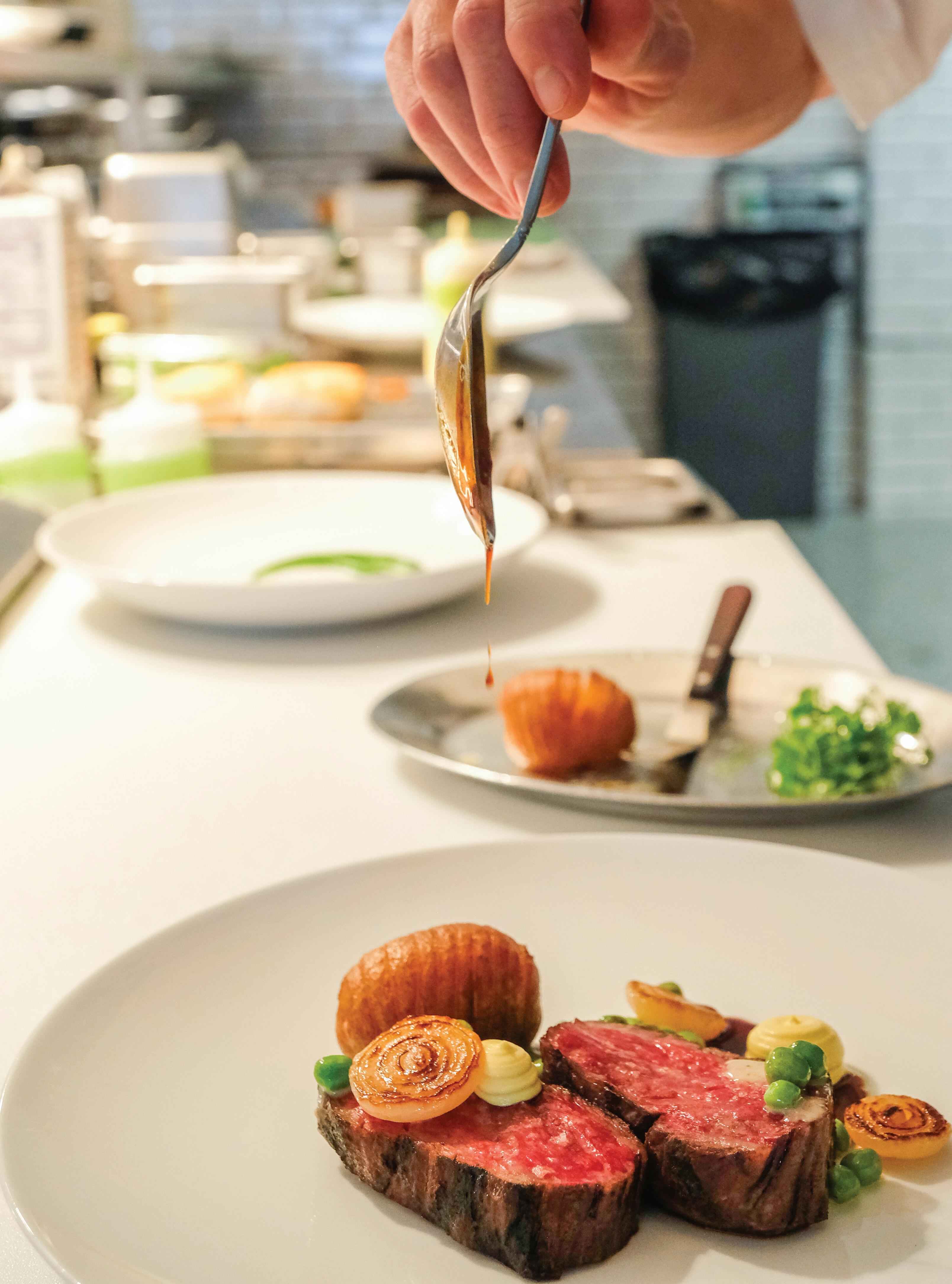
10
Investing In a Helping Hand Premade pastry, the unsung hero of busy culinary departments, is stepping up its game.
12


Going Beyond the Board
Club chefs are leveraging the artistry of sausage-making and charcuterie to educate and inspire culinary teams, while providing members with distinctive o erings.
16 Beyond California
Whether your members prefer the bold wines of the West or the Indigenous grapes of the East, America has special wines to o er.
18

Small Bites Bring Big Delights
A feast for the senses, hors d’oeuvres help kick o special events with mouthwatering appetizers and eye-catching displays.
20 Managing Member (Mis)behavior
Scott Craig, WCMC, Executive Chef of Cullasaja Club, o ers strategic insights on managing challenging members with key tactics like maintaining a professional demeanor and diplomatically addressing any issues that arise.


22
How Pelican Isle Yacht Club’s GM Leverages Her F&B Experience
Pelican Isle Yacht Club’s new Executive Chef, Roger Anderhalden, was chosen by GM Alisha Feezor, who discusses his suitability and anticipated challenges and opportunities.
CONTENTS September • Vol. 12 • Issue 5 D
4 l Club + Resort Chef l September 2023 www.clubandresortchef.com
Less Prep, More Pours
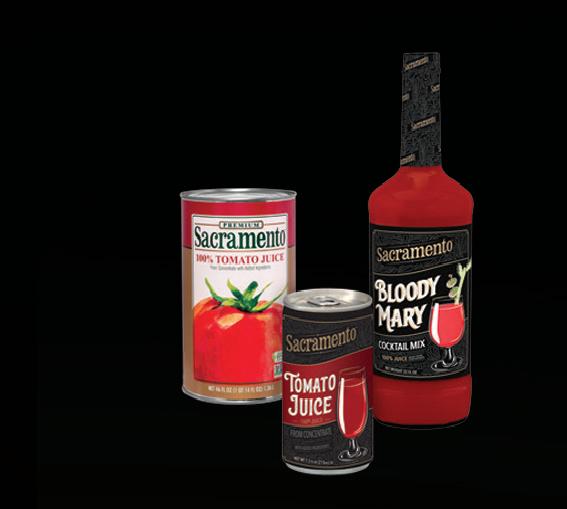
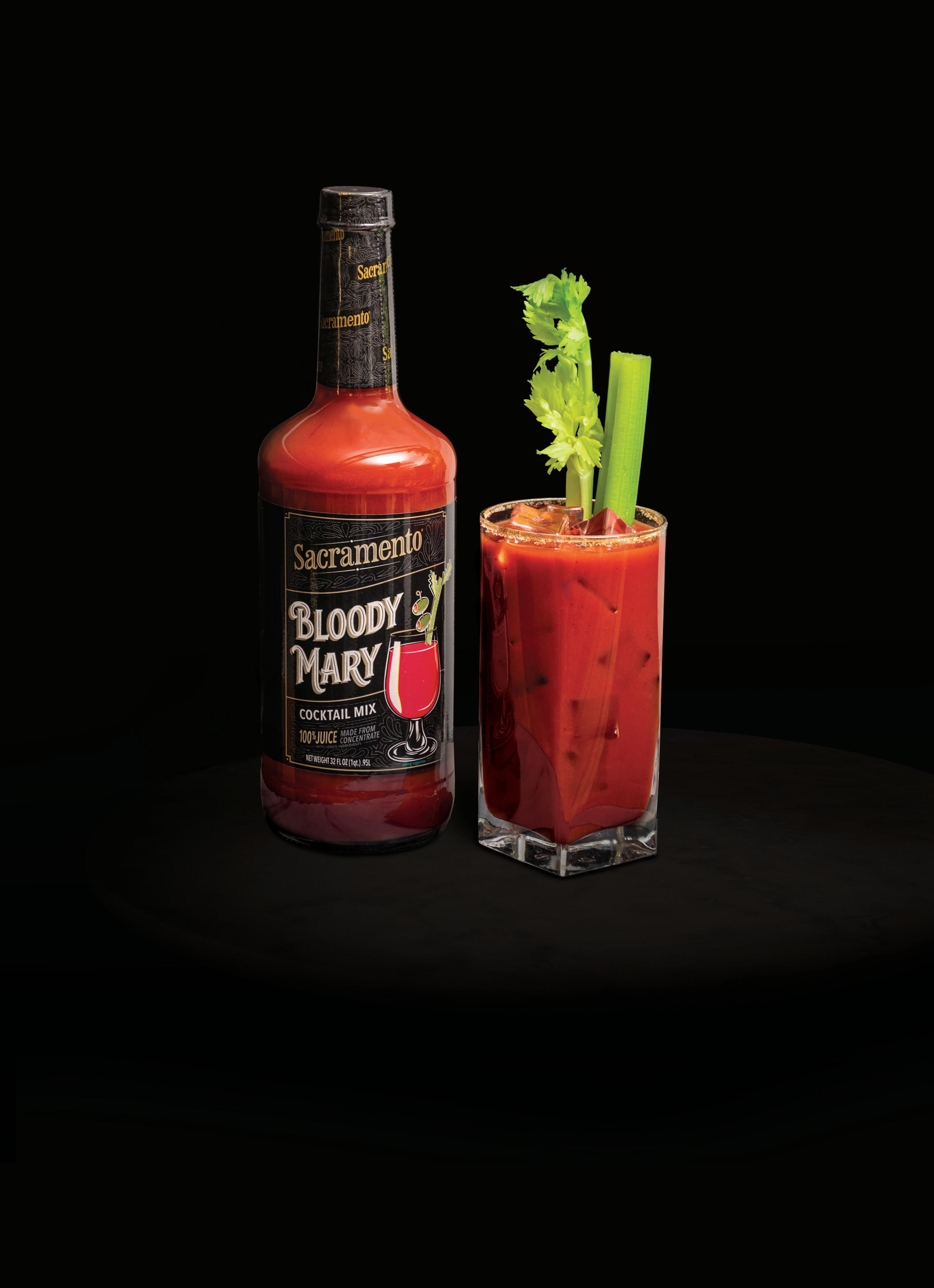
Sacramento® Bloody Mary Mix comes fully prepared with all the high quality ingredients you’d need to create the perfect cocktail for your menu! With its full body flavor and ready-to-serve convenience, bartenders and restaurant owners will be able to save time and labor costs at the bar. Get $5 Off Per Case Rebate when you use our QR Code, or order YOUR FREE SAMPLE at RedGoldFoodservice.com/Sample-Requests SACRAMENTO IS A REGISTERED TRADEMARK OF RED GOLD, LLC, ELWOOD, IN
Making a Name for Themselves: How The Union League Invests In Its Chefs
By Isabelle Gustafson, Senior Editor
FOR DENNY SANTIAGO, Executive Chef of Union League Liberty Hill (Lafayette Hill, Pa.), food has always been synonymous with family.
Growing up in a Puerto Rican household in Philadelphia, “food would just appear,” he recalls. Especially around the holidays, “the house permeated with all these beautiful aromas: morcilla, chicharrones de cerdo, pasteles, arroz con gandules,” he says. “Everyone would be cooking and enjoying one another’s company.”
Camaraderie and hospitality have become enduring themes in Santiago’s accomplished career, which reached its pinnacle last year with the debut of the Union League’s latest restaurant, Marquis by Denny Santiago.
“It’s a way to honor my family,” says Santiago. “At the heart of Marquis, we want [members] to feel at home.”
A DINING DESTINATION
The Union League of Philadelphia acquired Union League Liberty Hill in 2021. The purchase of the formerly public course and clubhouse further expanded the club’s facilities beyond its flagship downtown Philadelphia location.
Today, the League offers its 4,200 members an array of amenities across five companion properties: The Bungalow, The Union League Golf Club at Torresdale, The Union League Guard House, Union
League National Golf Club, and Union League Liberty Hill. Martin Hamann serves as the the League’s Executive Chef, overseeing the club’s entire culinary operation and team. He and Santiago have worked together for 30 years now.
After culinary school, Santiago secured a job at the Four Seasons Hotel in Philadelphia, a move that, as he puts it, “changed the trajectory of my career.”
There, he worked under Hamann, as well as Tony Clark and renowned French chef Jean-Marie Lacroix. Each of these chefs played an instrumental role in Santiago’s career.
“The Four Seasons was a no-nonsense place,” he says. “There was a level of perfection [expected]. It was very, very challenging. I remember saying I would be there about a year; fifteen years later, I was a sous chef running one of the restaurants.”
In 2008, Hamann left the Four Seasons to join the Union League and open a restaurant under his own name: 1862 by Martin Hamann. Eight months later, Santiago joined him as Executive Sous Chef.
“[Hamann] put the Union League’s culinary program on the map,” says Santiago. “I jumped at the opportunity to work with him again.”
Dozens of other culinary staff members left the Four Seasons for the Union League, says Santiago. “It wasn’t that we were calling people; they were calling us,” he clarifies. “They were calling him.”
“We always say [Hamann] is like the godfather of
CLUB PROFILE
6 l Club + Resort Chef l September 2023 www.clubandresortchef.com
As The Union League of Philadelphia celebrates the first anniversary of Marquis by Denny Santiago, the restaurant’s namesake continues a decades-long legacy of mentorship and culinary excellence.
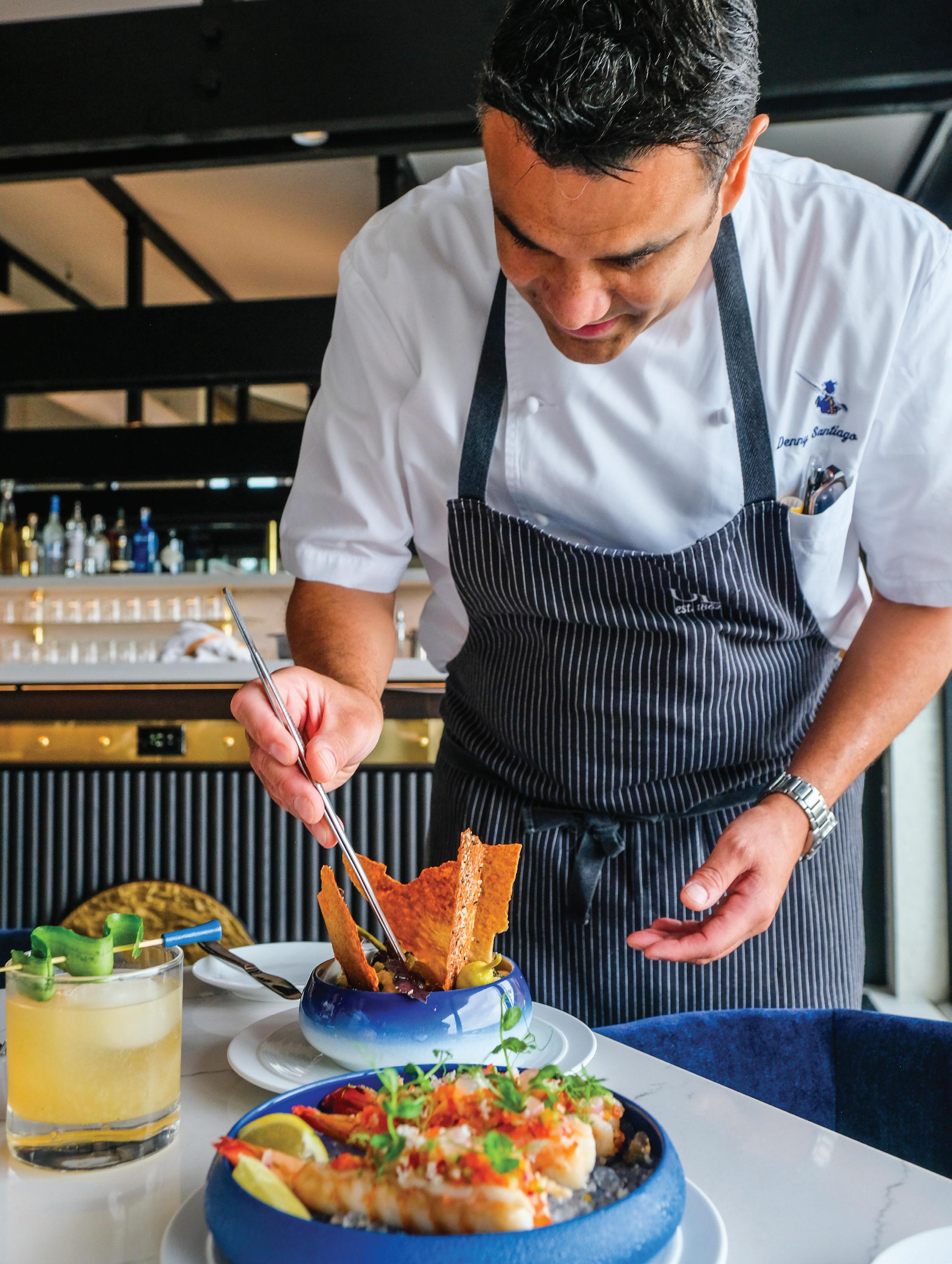
the kitchen,” says Katie Sacchetta, the Union League’s Executive Food and Beverage Director. “There’s a distinct di erence between eating and dining. He took us to that next level: a dining destination.”
When the League purchased Liberty Hill, Santiago and Executive Sous Chef Jim Gallagher were asked to run the culinary operation and open a brand-new restaurant.
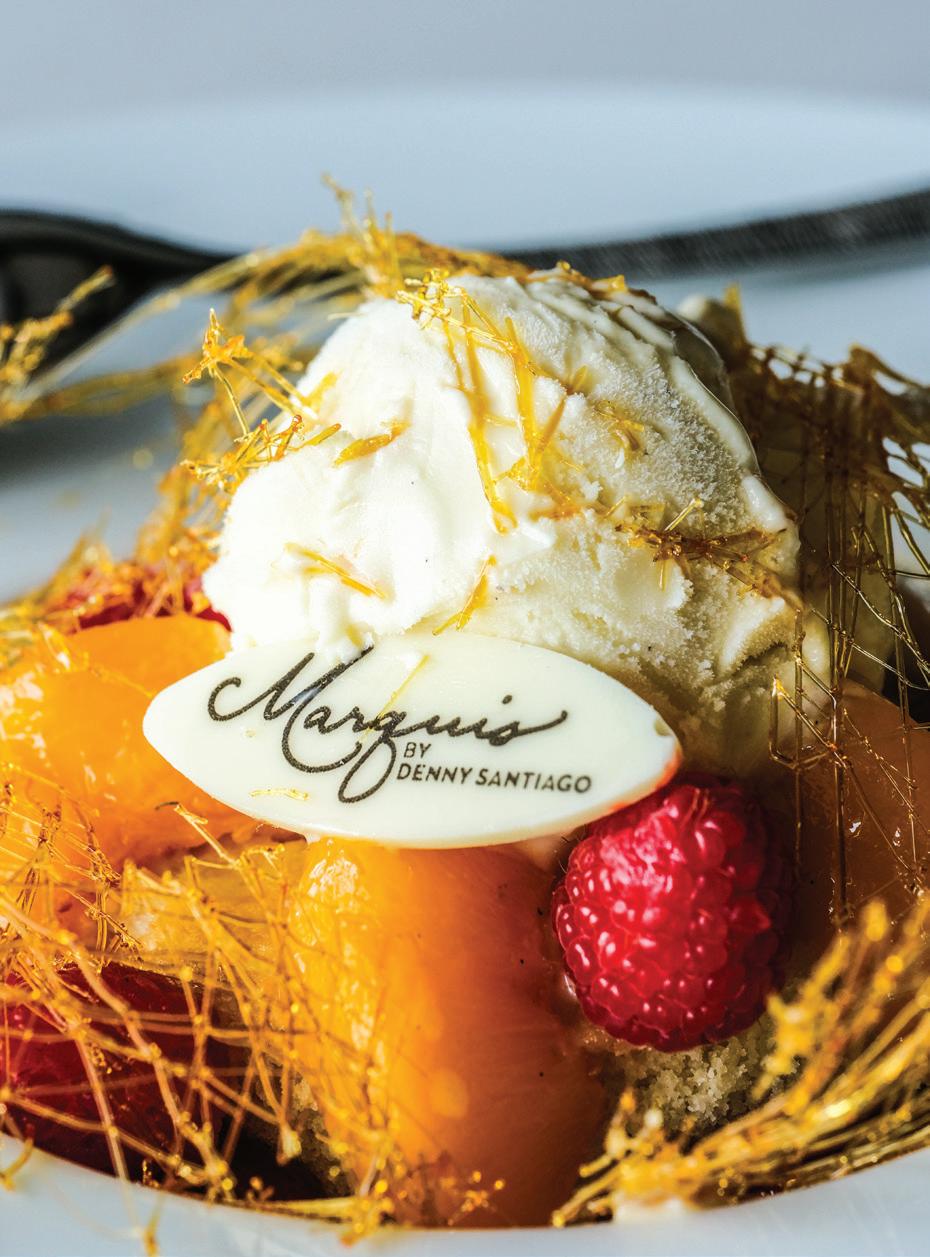
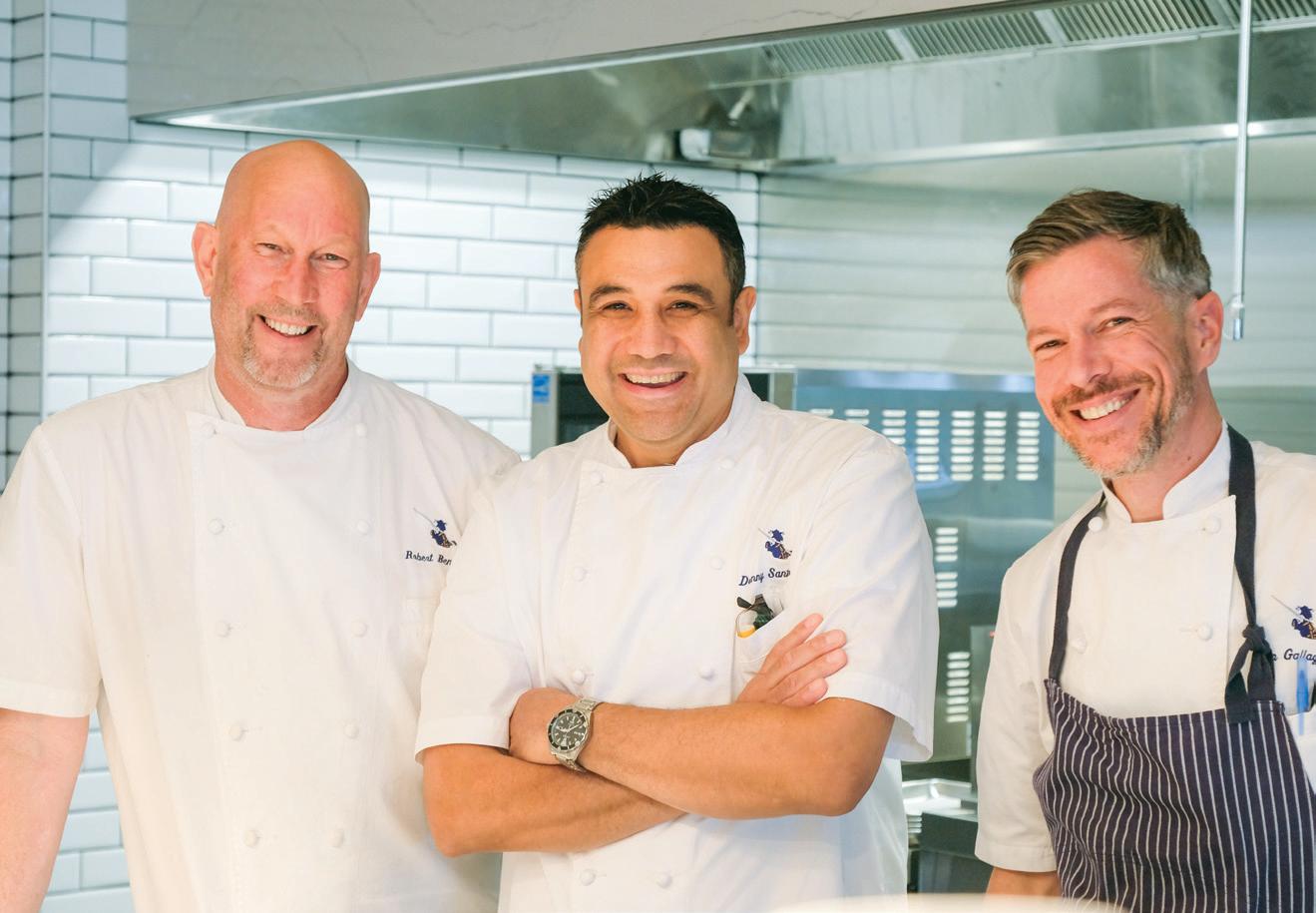
By this point, Santiago had worked at the League close to 15 years, helping to facilitate the opening of multiple restaurants and amenities across a number of locations. As the only other restaurant with a chef’s name attached to it, Marquis set the tone for the level of quality and service members could expect.
“It was time for [Santiago] to put his name out there,” says Hamann, just as he’d done with 1862. “That’s what the whole industry is about—at least for me now. I want people to grow, knowing that when I leave the Union League, it’s going to be in good standing. ... [Santiago] and [Gallagher] are dynamite chefs. I told them to be themselves.”
Just as Hamann o ered Santiago the opportunity to help remodel the League House kitchen years prior, Santiago asked that Gallagher work with him to design Marquis’ kitchen.
“It was important to him that I was involved,” says Gallagher. “We built this restaurant—[paying attention to] every detail. That experience was incredibly valuable.”
Gallagher, too, is a Philadelphia native and a Four Seasons alum. Sacchetta likens them to brothers.
“Ever since I’ve known him, from the Four Seasons in 1992, he’s been my boss, my chef,” says Gallagher. “That said, he’s family to me. ... When I interview young [chefs], I’ll tell them, ‘I’ve [known] this guy for 30 years.’ To me, that carries weight. There’s a lot of trust that can only exist after that many years.”
Santiago and Gallagher agree on most things. When it
comes to hiring and training new sta , they both say the most important factors are not skill nor experience but attitude, kindness, and a willingness to learn and to pass that information on.
“I think that’s the secret sauce,” says Gallagher. “I’m going to give everything I possibly can to you that was given to me freely. Ultimately, we’re building something bigger than any one of us.”
CAVIAR AND CAMARADERIE
Marquis by Denny Santiago is the League’s most modern dining venue, its open kitchen a perfect metaphor for the chefs’ leadership style and sense of hospitality. When members walk into Marquis, they’re immediately greeted by Santiago and team who are experts at balancing a strict standard of culinary excellence with a certain sense of camaraderie and humor.
Menus change four or five times a year, plus specials. The cuisine is contemporary—creative takes on meats and seafood, handmade pastas, plus handcrafted cocktails and an impressive pastry program, all of which center around fresh, seasonal ingredients.
“Some chefs start with the protein and work around that,” says Santiago. “We hyper-focus on the seasonal produce. We talk to our purveyors to see what’s fresh and trending, then we write menus around those items.”
Heirloom tomatoes and watermelon were among the stars this summer.
“We have a jumbo lump crab cake on the menu with heirloom tomatoes and an herb crust,” says Santiago. “We also o er Atlantic halibut with fresh corn, a little potato, and an espuma on top. There’s a burrata salad with compressed melon and a watermelon consommé that we pour inside, [garnished] with a drizzle of basil oil that floats on top.”
The menu layout includes a section designed for sharing and sparking conversations, says Santiago.
8 l Club + Resort Chef l September 2023 www.clubandresortchef.com
Marquis’ culinary leadership team includes (from left to right) Executive Pastry Chef Robert Bennett, Executive Chef Denny Santiago, Executive Sous Chef Jim Gallagher, and Chef de Cuisine Andrew Ryan (not pictured).
Marquis
o ers contemporary and creative cuisine with a special focus on seasonality. The restaurant’s signature
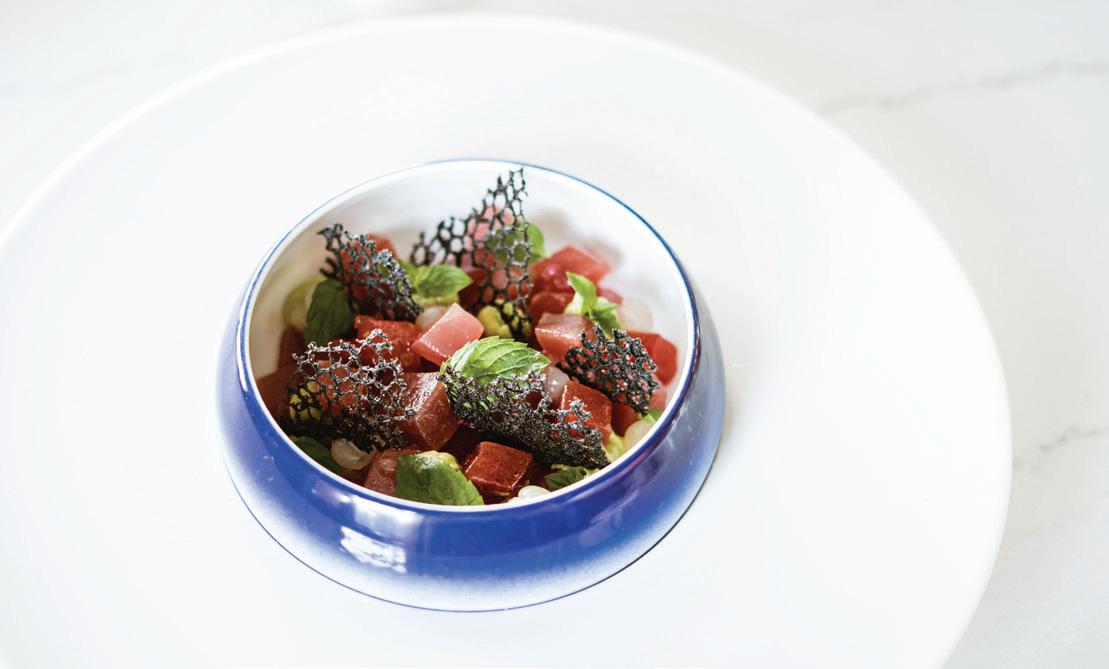
“Our 32-ounce veal chop is presented on a guéridon and carved tableside. Our namesake dish, The Grand Marquis (pictured top right), is a seafood tower. Depending on the time of year, it might feature a tartare, crudo, or ceviche, accompanied by a tin of Royal Daurenki caviar.”

The League’s members have sophisticated palates, Santiago notes, so each dish is meticulously considered from every angle to provide the highest quality and most imaginative presentations and flavors.
“We have a smashburger on the menu,” Santiago says, as an example, “and it’s dynamite. The meat and cheese are exceptional quality, we make our own sauce and pickles. The buns are made in-house, too.”
In fact, all of Liberty Hill’s breads are made in-house. The pastry team, led by Executive Pastry Chef Robert Bennett, produces six types of bread, including a Japanese milk bread with acacia honey for the table.
Bennett joined the Union League two years ago, after an impressive 14-year run as the Executive Pastry Chef of Le Bec-Fin, a renowned Philadelphia institution under the helm of esteemed French Chef Georges Perrier.
A nod to Le Bec-Fin is Marquis’ miniature dessert cart, named Avery Ann’s Cart after Bennett’s first granddaughter.
“Again, I wanted this restaurant to pay homage to our families,” adds Santiago. “The chef presents each item from the cart at the table, and members are truly ‘wowed.’”
This fall, Marquis will unveil a new addition to the dining experience named after Santiago’s daughter. The dessert—“Sweet Juliet”—features a series of signature petit fours and mignardise known as “Hidden Jules.”
On the dessert cart, Bennett o ers a wide range of textures and flavors for any palate: citrus, chocolate, nuts, crunch, frozen, and fruit. “We always have a cheesecake of some sort because it’s relatable,” he says. “And because we’re in the States, there’s always something with peanut butter.”
Since its start, Marquis has experimented with plated desserts, but “they sort of fall by the wayside,” Bennett notes. “They want the cart.”
But, he adds casually, “we also make sou és, jams—I like to pick my own fruit—chocolates, gelato andsorbet, two kinds of pu pastry—I personally love variety.”
A FIVE-STAR RESORT CLUB
The next venture for The Union League of Philadelphia is its eagerly anticipated tenth restaurant, scheduled to open by the end of the year at the League House.
This indoor-outdoor rooftop spot, christened ‘Trumbauer’ in honor of an influential early 20th-century American architect and League member, promises 150 seats and panoramic city views, with wood- and coalburning ovens and grills.
At the Liberty Hill location, “the sky’s the limit,” says Sean Palmer, the League’s Director of Golf and Liberty Hill’s General Manager.
“Within the next year, we plan to expand our ballroom,” he says. “In about three years, we’ll embark on a major project: a fitness facility with indoor-outdoor aquatics. Beyond that, we’re looking to bring some big golf events to the facility.”
Santiago aims to redesign the banquet kitchen at Liberty Hill and create a studio kitchen space for both savory and sweet demonstrations.
“[Bennett] could host baking classes,” says Santiago. “I’ve always envisioned Willy Wonka & the Chocolate Factory; I want to create a space where members can see him working with sugar and chocolate.”
“I never would’ve thought that I would have a restaurant with my name on it,” adds Santiago, reflecting on the past year. “Liberty Hill is evolving so quickly. ... I’m proud to be part of something great—and to have the opportunity to bring other chefs along for the ride.” C+RC
www.clubandresortchef.com September 2023 l Club + Resort Chef l 9
by Denny Santiago
dish, known as The Grand Marquis, is a seafood tower (on the right). Among its summer starters was an ahi tuna tartare (on the left) with compressed watermelon, avocado espuma, mint, and lime gelée, garnished with a squid ink tuile.
Investing in a Helping Hand
Premade pastry, the unsung hero of busy culinary departments, is stepping up its game.
By Pamela Brill, Contributing Editor
INDULGE IN A CULINARY
fantasy, if you will. Imagine being gifted a product that would save time and money in the kitchen without skimping on quality. Enter the premade pastry, a must-have that enables chefs to finetune their finished product—instead of waiting for dough to rise.
Chefs in the know share their experiences using premade pastry products: how it boosts productivity and gives them more opportunities to focus on menu planning and recipe execution.
A SURE BET
It was members’ good fortune this past June when Pastry Chef Jennie Miller left the casino industry for a new position at the Union League Club of Chicago. While both markets have their own banquet and a la carte operations, the private club environment allows Miller to understand her clientele better.
“At the club, you are seeing the same faces and are able to get to know their preferences and cater to them more e ciently and personally,” she explains.
Miller allocates her resources wisely to fulfill members’ expectations, particularly as the club rebuilds its pastry program.
And because she is working with a limited sta , that means relying on premade pastry products like croissant dough, Danish dough and tart shells, all of which provide considerable savings to her bottom line. “There is no sheeter [at the club], and the labor
involved with making [croissant dough] from scratch would make the cost astronomical,” she points out.
Premade pastry in Miller’s current repertoire includes a 3-inch tart shell for key lime pie (“the perfect size for plating”) and a 2.1-inch tart shell for bu et setups.

Of course, the downside of premade pastry usage is quality control, prompting Miller to take extra steps to ensure consistency. Shipping woes are also contending; products must be e ectively packaged to minimize damage and additional fees.
Miller expects to rely heavily on premade pastry for the upcoming holiday season when she’ll employ a variety of products on her menus. The upside: having more time to create homemade
fillings, including di erent flavors of ganache, curds and mousse, as well as house-made pecan pie, frangipane and clafoutis tarts. “If I want to take it to the next level, I will fill the tart shell with, say, a ganache or Namelaka and then create a molded mousse to put on top of that,” she adds.
ROBUST PUFFS
At the Everglades Club in Palm Beach, Fla., premade pu pastry sheets are a hot commodity for Executive Pastry Chef Matthew Ratli , WCMPC, CMB, CEPC, who lauds them for their myriad benefits.
“As the need for pu pastry comes in, I don’t have to divert labor or use overtime to produce it,” he says.
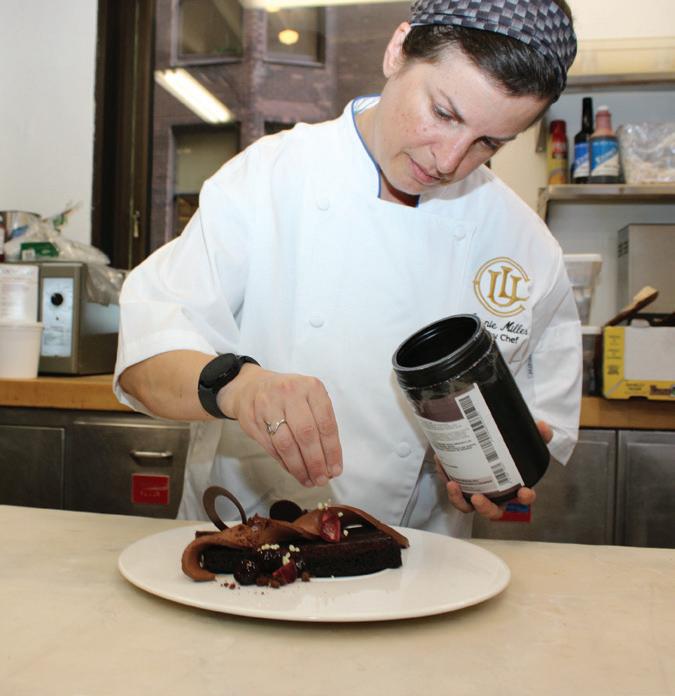
PASTRY
10 l Club + Resort Chef l September 2023 www.clubandresortchef.com
The Union League Club of Chicago’s Pastry Chef, Jennie Miller, utilizes premade pastry items including a 3-inch tart shell for key lime pie and a 2.1-inch tart shell for bu ets.
It’s a must for banquets, which are plentiful at the bustling Florida club.
Determining which pastry products Ratli can outsource stems from a storied culinary experience that began fresh out of high school at the Silver Lake (Ohio) Country Club.
He recalls how a limited sta and lack of equipment prompted the kitchen to rely heavily on premade pastry (“Take them out of the box, garnish and go.”)
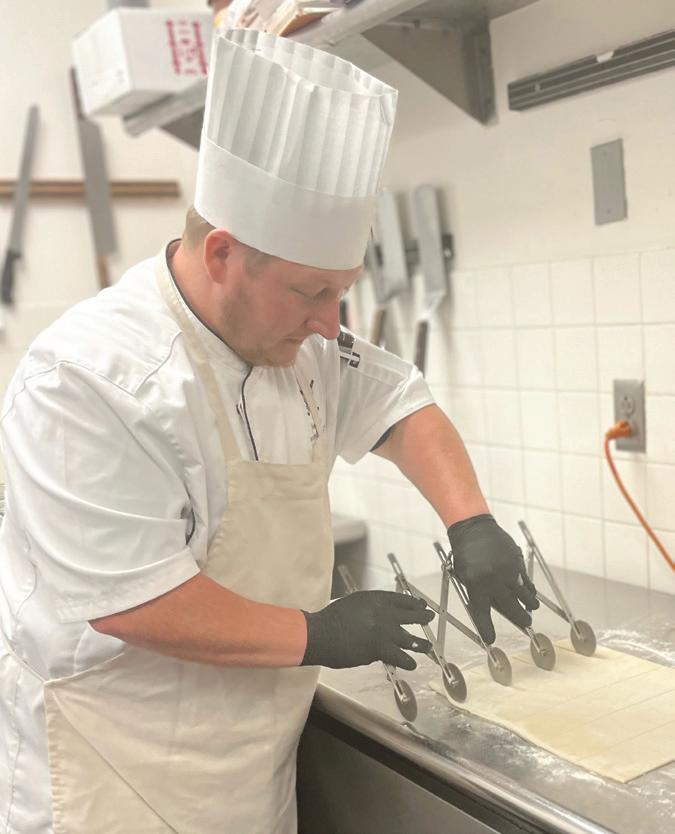
This approach was especially familiar when Ratli first joined the Everglades Club as an assistant pastry chef 15 years ago when a five-person sta limited operations and premade pastry became a necessity.

Today, Ratli ’s kitchen has beefed up its sta to 18, enabling more products to be made in-house—something that does come at a cost. “I feel very fortunate to have a membership that is aware and wants as much of their food made from scratch as possible,” he says. Even with a solid workforce, his kitchen still uses premade pu pastry sheets and hazelnut paste. High-quality pu s have their advantages over other
standard products. “Because it has no yeast, its shelf life in the freezer is six months-plus, unlike croissant or Danish dough, which deteriorates in weeks,” notes Ratli .
Because of the premade pu ’s versatility, it is used for savory items, like vol-au-vents and fleurons, and sweet pastries, including apple turnovers, mille feuille and pithivier.
Premade pastry gets plenty of mileage at the Everglades Club, particularly during banquets, when headcounts can range from ten to 800 guests.
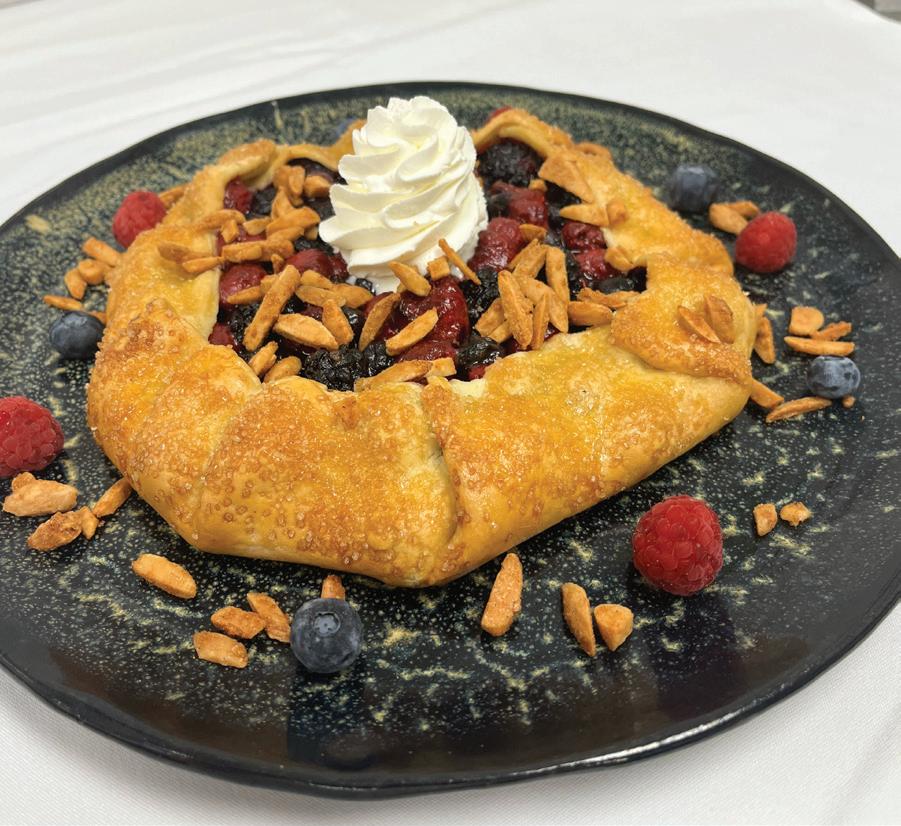
“Being able to buy a high-quality, consistent product with no labor spent means you can accommodate any size banquet without sacrificing product quality,” says Ratli . “Premade products might be the di erence in accepting the party or turning it down.”
Having a supply of premade products also helps when calculating costs because prices are more predictable, unlike basic ingredients that fluctuate with supply and demand.
Before the kicko of the holiday season, Ratli expects to have extra pu pastry on hand to serve the club’s growing number of pop-up events. He can easily use premade products for plated desserts, petit fours and other bu et-style pastries.
For any skeptics who are not 100 percent sold on premade, Ratli recommends experimenting and tastetesting house-made versus purchased pastry items. “This will weed out those inferior products,” he says.
PREMADE DOUGH: THE WAY TO GO
In addition to employing this staple for the past five and half years in his kitchen at The Country Club of Birmingham (Ala.), Executive Pastry Chef Chad Starr has relied on it his entire career. “It’s a real time and money saver,” he says of the club’s reliance on outsourced pu pastry, pie shells, phyllo dough and tart shells. “I have always used it in menu planning if it fits the idea I am going for.”
Because there’s a lag between dough making, chilling and rolling, outsourcing pastry products enables Starr to devote more time to enhancing his finished product. “Pastry doughs are very simplistic and neutral in taste,” he notes. “If you make a great filling and add lots of flavors, the pastry will shine.”
Starr uses premade pastry largely for special events due to the sheer volume, as well as in a la carte classic desserts, such as a Napoleon with fresh raspberries and key lime diplomat cream with white chocolate shavings and raspberry coulis. To counteract the lack of flakiness in premade products, he makes a point of baking it thoroughly, ensuring a crisp texture.
Premade pastry will have a starring role at the club this coming season. Starr plans to use purchased pie shells for staple desserts like chocolate fudge pie and pecan pies and tart shells for apple crumb tarts on banquet tables. On the savory side, pot pies will also incorporate premade pu pastry, o ering dinner diners a chance to experience the pillowy delicacy. C+RC
www.clubandresortchef.com September 2023 l Club + Resort Chef l 11
Everglades Club’s Executive Pastry Chef, Matthew Ratli , uses premade pu pastry sheets to meet member demand, keeping labor considerations in mind.
Executive Pastry Chef Chad Starr says The Country Club of Birmingham often outsources pu pastry, pie shells, phyllo dough and tart shells.
Going Beyond the Board
Club chefs are leveraging the artistry of sausage-making and charcuterie to educate and inspire culinary teams, while providing members with distinctive o erings.
By Joanna DeChellis, Director of Editorial and Programming
CHARCUTERIE AND SAUSAGE-MAKING blend artistry with science. Crafting charcuterie involves curing, smoking, fermenting, and aging meats, while sausagemaking encompasses mixing, grinding, and stu ng. Both require a deep understanding of flavors, textures, and the transformative power of time.
Beyond the delicious products that result from these processes, club chefs are discovering the educational and experiential value they bring to their culinary teams and the unique o erings they provide to their members.
For Jeremy Leinen, CEC, Executive Chef of Parkridge Country Club (Rochester, N.Y.), these two disciplines have remarkable staying power, especially as the cost of goods continues to rise.
“Filets, ribeyes and pork chops are expensive, so it makes a ton of sense to showcase these less expensive cuts of meat in ways that underscore the skill of the culinary team,” says Leinen. “Particularly in bar settings, where people are socializing and sharing, charcuterie boards are becoming more and more the focal point. I lived in Chicago just a few blocks from Lardon, a restaurant built almost exclusively on its charcuterie o ering. Talk about being a kid in a proverbial candy store. Bottom line—I think charcuterie is a phenomenal way for club chefs to make a mark on their operation and showcase their skill to their membership while also teaching their teams something artistic and useful.”
SEASONAL SAUSAGES
Leinen tends to play it safe with sausage-making and relies on classic recipes as his guide.
“I use recipes for bratwurst,jagerwurst, and weisswurst as a blueprint and don’t try to push the boundaries too far when I want to nudge recipes in a certain direction,” he says. “Classics are classic for a reason, and they generally
o er the balance you’re probably looking for. That said, you can always swap ingredients in and out—maybe go a little heavier on a certain seasoning if you’re looking for more of this or that. But the classic proportions are typically a great guideline to follow.”
John Comerford, Executive Chef of LaGrange (Ill.) Country Club, agrees and suggests only changing one element each time you want to evolve or refine a product.
“If you’re changing too many things at once, the flavors you’re looking to develop can get lost,” he says. “Be pragmatic and keep good records.”
LaGrange’s culinary team is fortunate to have a steak locker that they’ve turned into a dry-aging box where they plan to hang sausages while the club undergoes various renovations for the next few years.
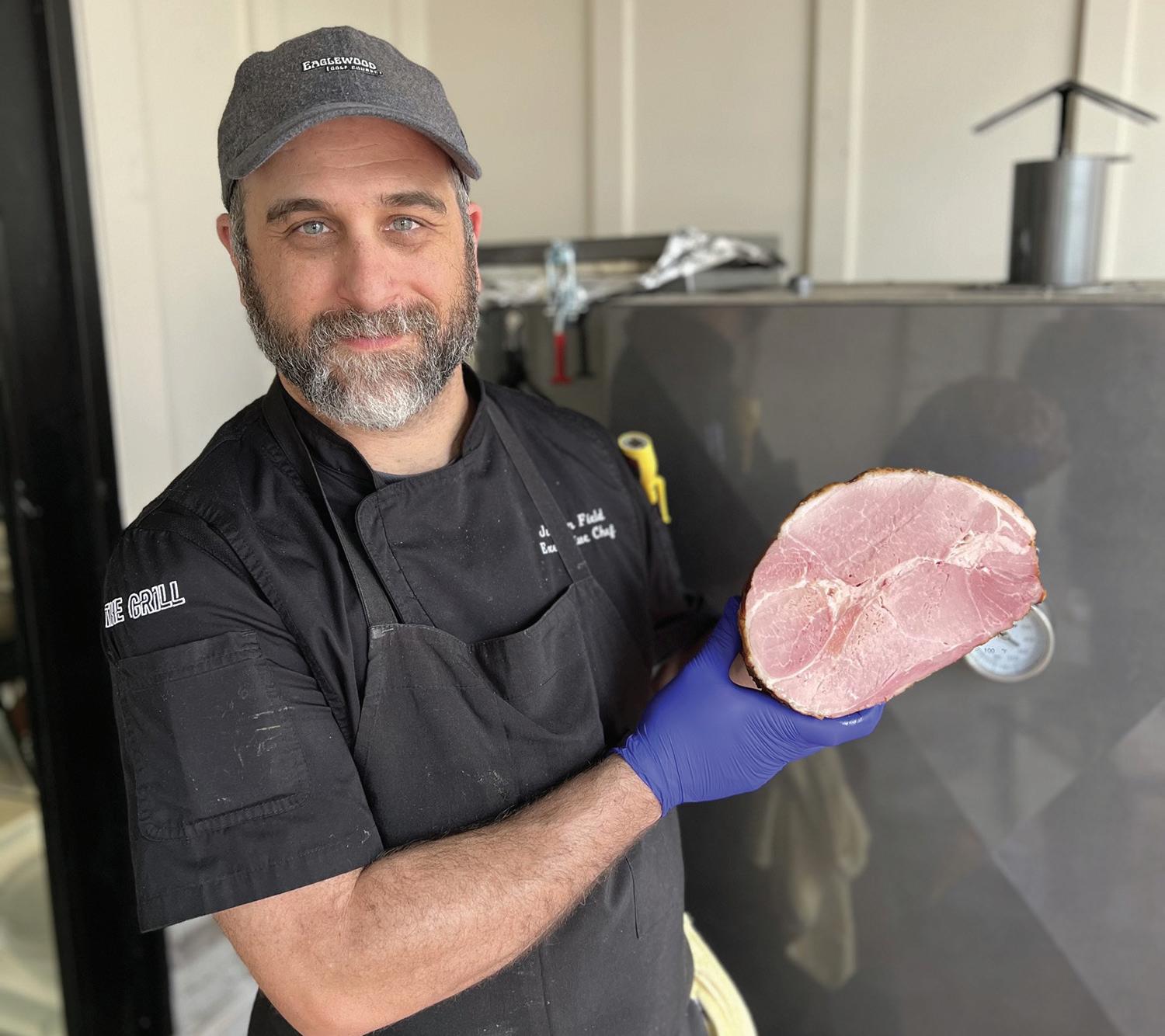
So far, the most popular sausages at LaGrange have been duck sausage, a 55-day dry-aged beef sausage and a southern-style hotlink. Much like other parts of the menu, Comerford and his Sous Chef, Jason Kurosaki, try to mind seasonality with sausage-making while also finding clever ways to showcase these items for members.
“During our fall wine festival, we created an action station with charcuterie and sausages that complemented many of the wines being featured,” says Comerford. “Members
12 l Club + Resort Chef l September 2023 www.clubandresortchef.com
FOOD + BEVERAGE
Justin Field, Executive Chef and Kitchen Manager for Eaglewood Golf Course and Event Center, is known for his innovative charcuterie program that enhances the club’s lunch o erings.



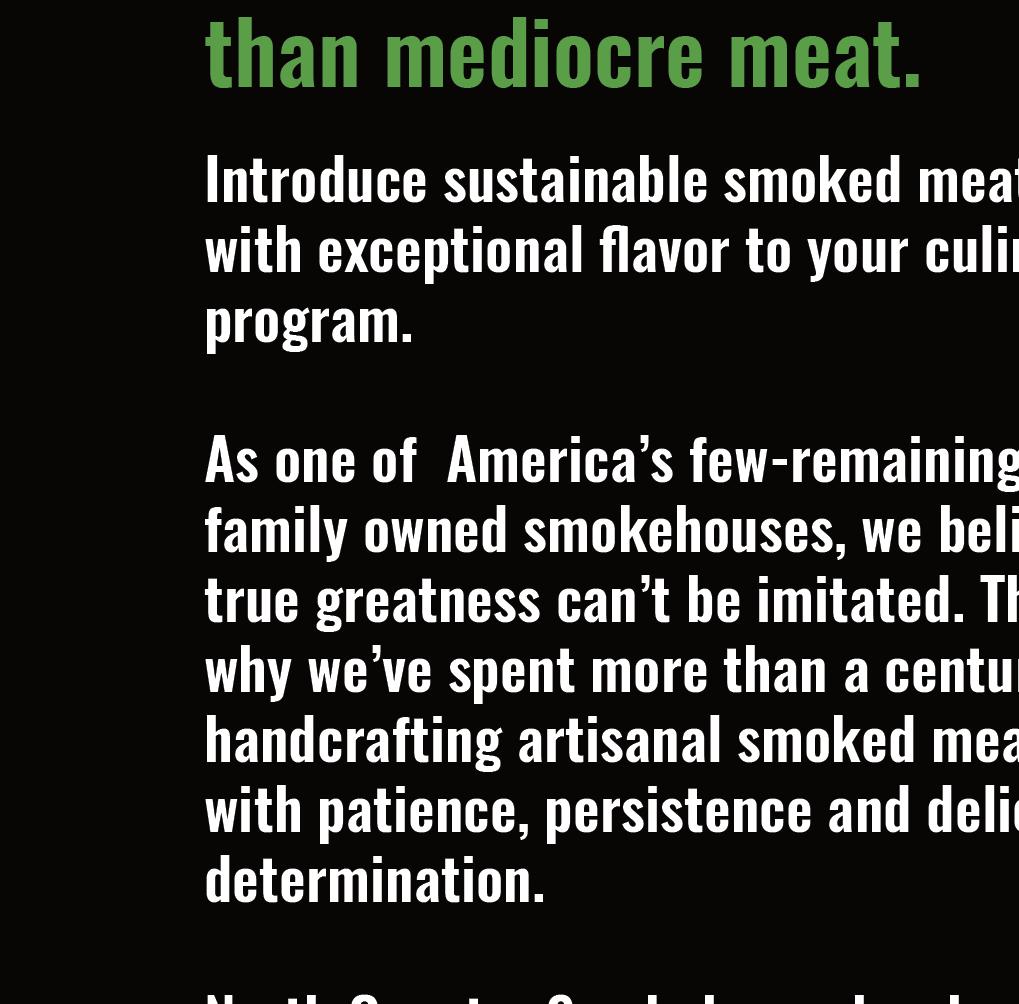
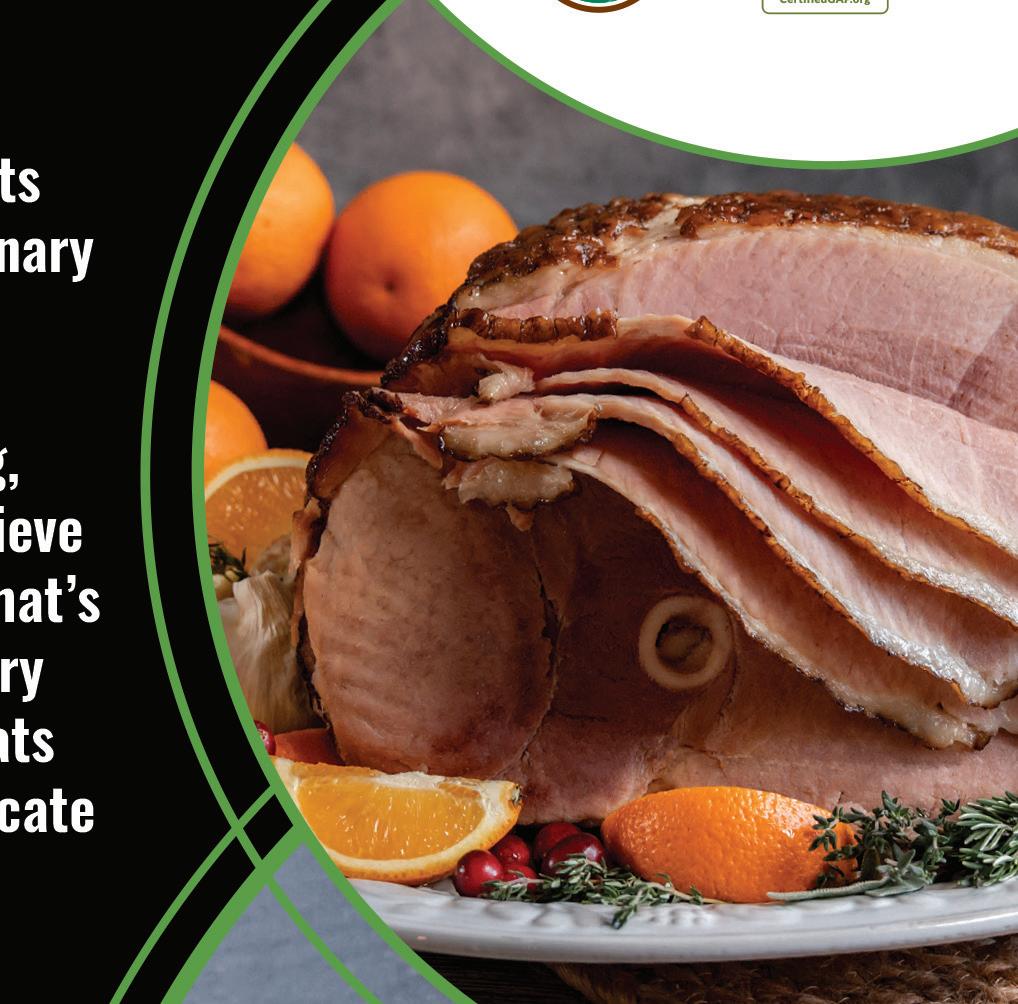
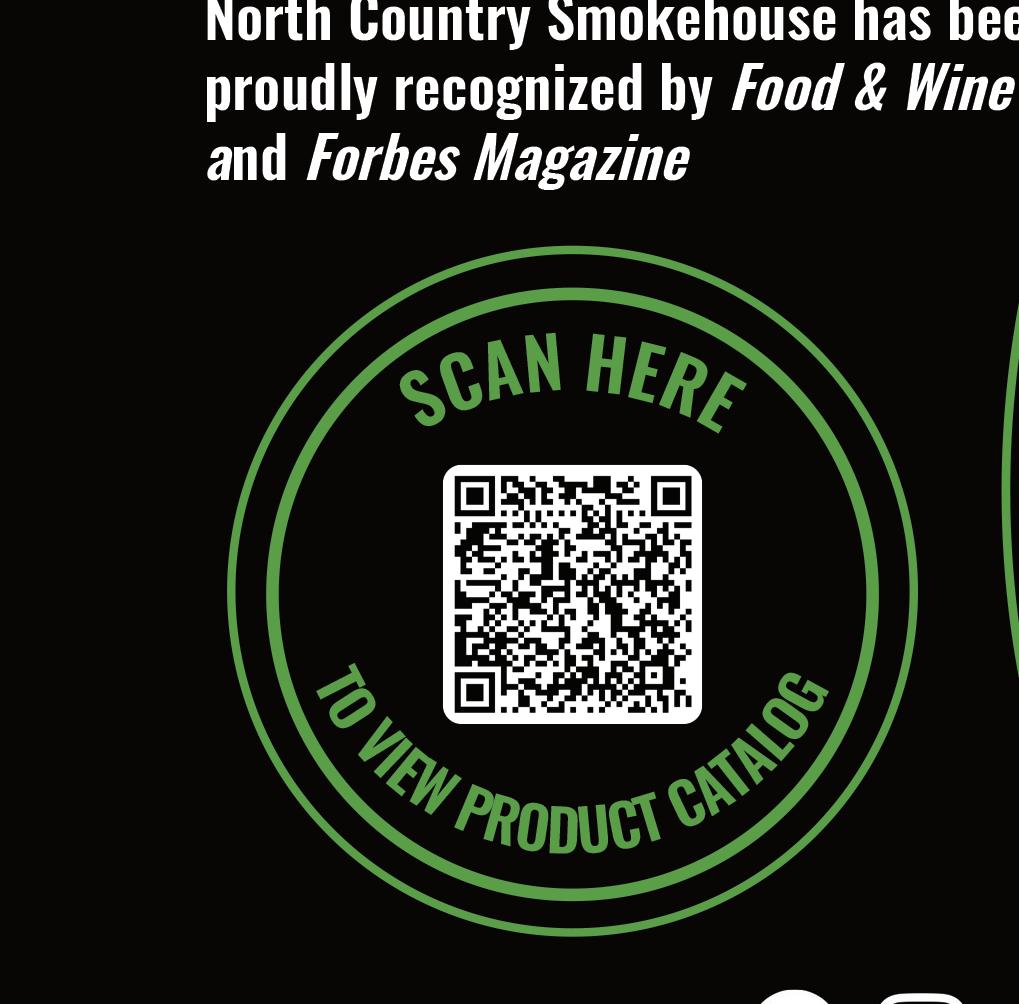
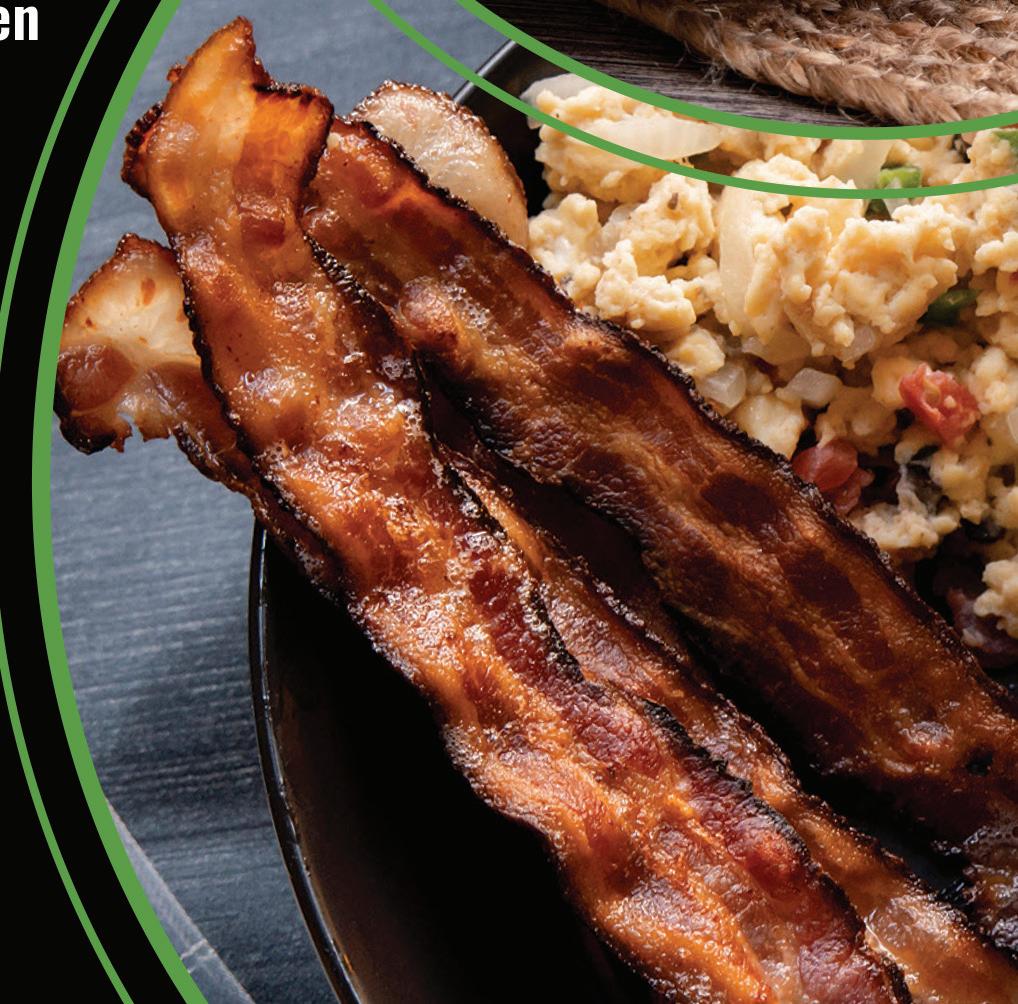
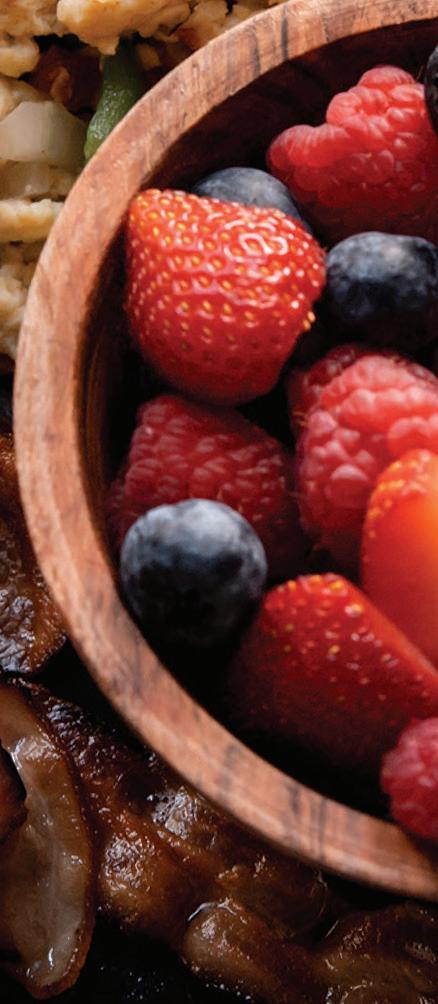

really enjoyed the station because it was not only different than your typical banquet stations but also because they were able to try things they’ve never had before. They were especially proud of the fact that their culinary team made these items in-house.”
Ultimately, sausage-making comes down to member preference and lots of trial and error.
“In every club I’ve ever worked, I always start by introducing the classics first,” says Leinen. “Getting a sausage program off the ground can involve heavy lifting, so don’t complicate it early. Sure, there’s some cool stuff you might see on Instagram, but I can’t tell you how positive the feedback always is when I deliver freshly made breakfast sausage for the first time.
“Most people haven’t tasted fresh sausage with that vibrant flavor,” he continues. “The same goes for bratwurst, Polish or Italian sausages served simply off the grill for a golf event. Members notice the difference without question—and you begin to gain their trust so that eventually they will be more inclined to try something a little less familiar.”
ON BOARD
Charcuterie celebrates the craft of preserving and enhancing the flavors of meats through various techniques like curing, smoking, and aging. Establishing a charcuterie program not only allows club chefs to showcase their skill and creativity but also provides a unique and customizable dining experience that can set the club apart.
For Justin Field, Executive Chef and Kitchen Manager for Eaglewood Golf Course and Event Center (North Salt Lake, Utah), charcuterie has been a game-changer—literally.
“Our members and guests are primarily here for golf,” says Field. “This means most of them each lunch with us. Charcuterie plays a critical part on our menus and allows us to offer a sandwich menu filled with house-made meats unlike anything they’d get elsewhere.”
Field was brought to Eaglewood and given free rein to establish the vision for the club’s culinary program. With so much lunch traffic, Field knew from the get-go that he wanted to create a charcuterie program to take the club’s sandwiches to a new level.
Today, the “lunch meat” at Eaglewood is second to none and includes a Cajun turkey, lamb ham, salami, duck pastrami, Parma ham, soppressata, capicola and more.
“Charcuterie-making can go well beyond charcuterie boards in the bar,” says Field. “Our signature club sandwich is a great example. It features our Cajun turkey on sourdough with lettuce, tomato, onions, avocado, sprouts, and a little mayo. Our golfers love it.”
WHERE TO START
All three club chefs agree that a HACCP plan must be approved before a club can begin a charcuterie program.
“The days of the health department just glossing over this are gone,” says Leinen. “There are consultants that will work with you to build this if you can’t do it yourself, and it will take a lot of the headaches out of the process. It’s not a trivial amount of money, but likely not a deal breaker, so plan for it.”
Beyond that, charcuterie programs start with great butchery work and high-quality ingredients.
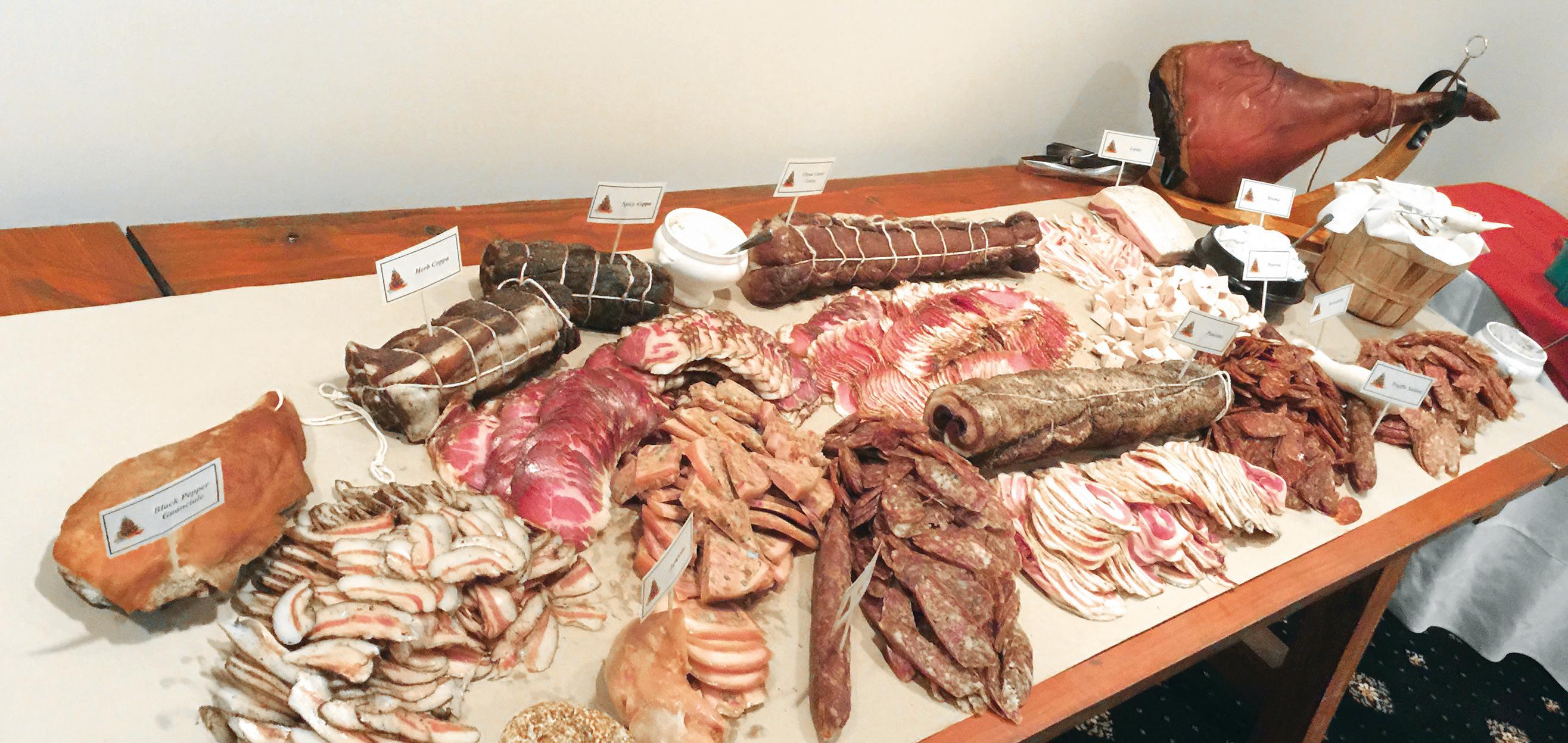
“You can’t concentrate what isn’t there,” says Leinen. “Sure, you can make Lonza from a commodity pork loin, but it’s likely to be bland and flavorless. Opting for a quality Berkshire product, or better yet, working with a local farmer, is worth the effort. The flavor will be noticeable in your end product.”
All three chefs agree that the more they lean into charcuterie, the more they rely on tradition.
“The technology and processes haven’t changed,” says Field. “We don’t need to reinvent the wheel. I am glad to see some of the tools, like the curing chambers, coming down in price to make this technique more accessible to all.”
“Honestly, this isn’t the place to try and be creative,” says Leinen. “There are well-established guidelines on proper temps for drying and fermentation, and trying to stray from these offers little reward. Trying to get a consistent result with these items can be tricky enough, so don’t try to get cute with it.”
“Charcuterie and sausage-making are now part of our core repertoire,” says Comerford. “While dining trends will always ebb and flow, sausage and charcuterie have stood the test of time. We believe it’s important for culinarians to learn these techniques to continue offering unique, high-quality products to our members.” C+RC
14 l Club + Resort Chef l September 2023 www.clubandresortchef.com





rationalusa.com Ergonomic kitchens? When pigs fly. Houston, we have lift-off. iVario. The Game Changer.
Beyond California
By
WHEN THINKING OF AMERICAN wine, California often takes the spotlight, but every state in the continental U.S. boasts its own wine production. The history of American winemaking dates back to the 17th century, coinciding with European colonization. Figures like Thomas Je erson attempted to cultivate European grape varieties on American soil but faced challenges. Native rootstocks, resistant to the destructive phylloxera louse, evolved in the U.S., yet were deemed inferior for wine.
Over centuries, American winemakers strived to graft European varieties onto native rootstocks. A breakthrough came in the mid-1800s when Nicholas Longworth produced the first commercially successful sweet sparkling wine from the native Catawba grape.
Despite California’s modern-day prominence, early viticulture pioneers, including German, French, Hungarian and Italian immigrants, played a pivotal role in its rise. Napa Valley and Sonoma Valley became centers for cultivating vinifera varieties like Cabernet Sauvignon and Chardonnay.
The diversity of American geography, from the cold climates of New York to the heat of New Mexico, presents an array of grape varieties and wine styles.
While international grape varieties found favor in the West, many Eastern vineyards remained loyal to native varieties or hybrids. Among these, several noteworthy grape varieties beckon the discerning palate as delectable alternatives to mainstream wines.

1. Norton: Distinguished as America’s oldest grape variety, it yields a full-bodied red wine characterized by firm acidity and a spicy profile.
2. Catawba: Primarily employed in the production of white and rosé wines, it imparts crisp berry flavors with subtle spicy undertones.
3. Chambourcin: A teinturier grape variety, its juice is naturally red, resulting in a robustly flavored red wine best served slightly chilled.
4. Muscadine (Scuppernong): Although its small clusters pose challenges for commercial harvest, it produces both red wines imbued with strawberry and sour cherry notes and white wines redolent of banana and bruised apple nuances.
5. Niagara: Yielding a white wine endowed with a grape’s sweet “foxy” character.
These native cultivars continue to evolve as winemakers explore their potential. So, before suggesting that Cabernet Sauvignon to your members, consider introducing them to America’s heritage and taste a piece of history in a glass.
WINE
C+RC
Whether members prefer the bold wines of the West or the Indigenous grapes of the East, America has something special for everyone.
www.clubandresortchef.com
Robert Mancuso, CMC, DipWSET, Contributing Chef Editor












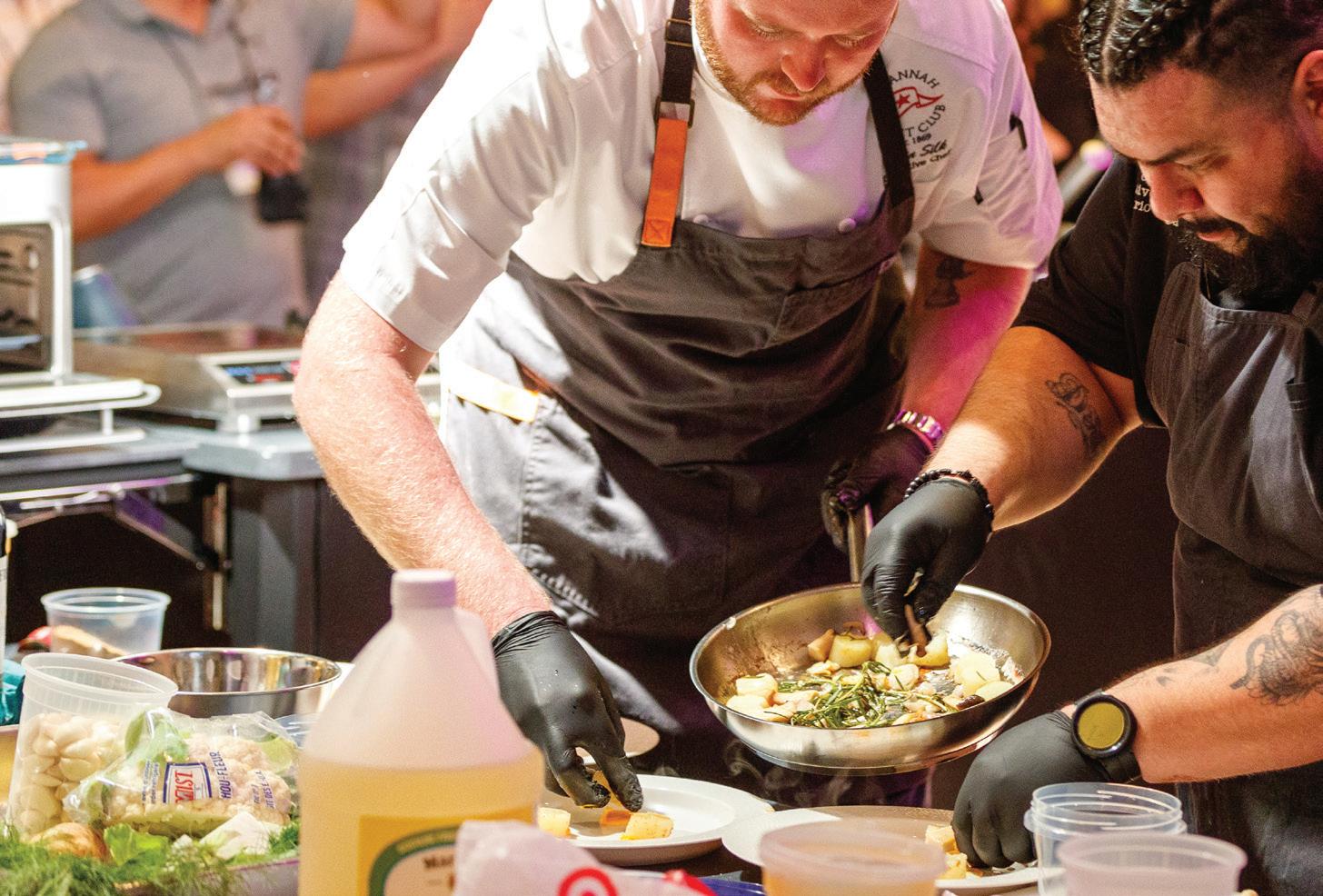
































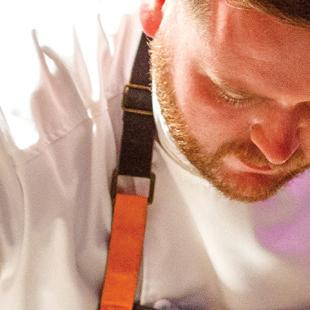









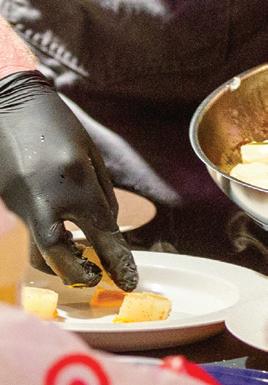
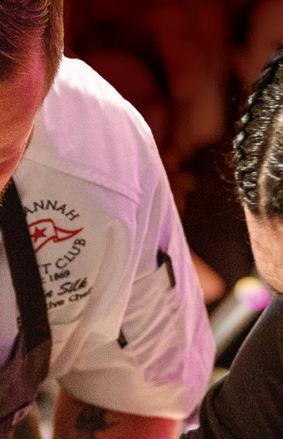

















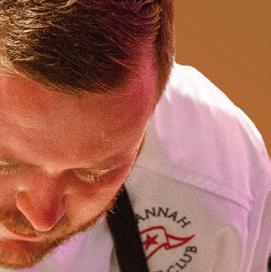




























TEXAS Austin Austin MARCH 3-5, 2024 REGISTRATION INCLUDES: • Attendee Gift • Welcome Reception, Keynote Address and Kickoff Party • Breakfast and lunches on Monday and Tuesday • General conference sessions and education • Live cooking demonstrations • Networking opportunities • Monday night Chef to Chef Community Event • Club + Resort Chef of the Year Culinary Competition and Reception • Continuing-education credits C2C IS COMING TO ATX cheftochefconference.com REGISTRATION NOW OPEN LEARN.NETWORK. be inspired. be inspired. be inspired.
Small Bites Bring Big Delights
By Pamela Brill, Contributing Editor
IN ONE CORNER OF THE BALLROOM
, plates heaped high with mussels fra diavolo and clams casino compete alongside shrimp cocktail shooters. In another spot, chefs dole out fresh pasta with mini meatballs and pesto penne while servers weave through the crowd carrying lambchop lollipops and plump pigs in blankets.
It’s all hands on deck for banquet season when passed and stationed hors d’oeuvres whet the appetites of members and guests. As chefs prepare their menus for weddings, golf tournaments and other catered events, they consider which trends are worth trying out and reveal the most challenging part of pulling o a perfectly paced lineup.
THE MIGHTY MINI
Bigger doesn’t mean better when it comes to creating standout hors d’oeuvres at Friendly Hills Country Club in Whittier, Calif. Executive Chef Peter Phan has been serving up miniature versions of popular dishes more frequently and notices that the pintsized trend continues to demonstrate tremendous staying power.
“People always seem to have an a nity for something familiar, but in a tiny version,” he says of his mini street (“sidewalk”) tacos, mini lobster rolls and bite-sized chicken pot pies.
Before joining Friendly Hills in 2015, Phan was the Executive Chef at SeaCli

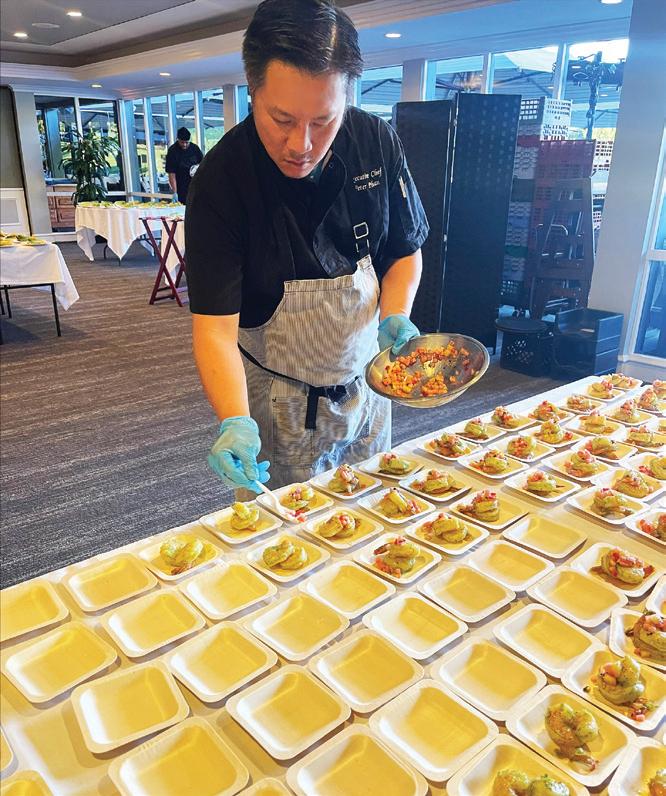
Country Club in Huntington Beach, Calif., for four years. His private club experience has enabled him to better understand his customers’ needs as he learns their preferences for passed versus stationed options and incorporates some of his own ideas.
“I create selections seasonally, but I usually like to keep the few popular [ones] all year round,” he adds.
While Phan does not see classic hors d’oeuvres phasing out in favor of new trends, he recognizes the opportunity to revamp tried-and-true favorites into new versions. One example is the charcuterie board, which has gained
traction thanks to social media. “This is a classic that just reinvented itself,” Phan says. “I had my first charcuterie board when I was six: Lunchables.”
Another trend Phan has been seeing is raw or crudo foods, be it ceviche or poke. He counts ahi poke as one of his more popular selections and varies his serving style: on a simple skewer, a wonton chip and marinated in a cool amuse-bouche spoon. In fact, with more foodies using what he deems “culinary buzzwords,” Phan makes a point of peppering in favorites like wagyu, sous vide, hyper-local, smoked, organic and wild-caught when appropriate.
18 l Club + Resort Chef l September 2023 www.clubandresortchef.com
BANQUET
A feast for the senses, hors d’oeuvres help kick o special events with mouthwatering appetizers and eye-catching displays.
Mama Phan’s Wontons (right) require signi cant time to prepare the lling and stu the wrappers of bulk orders, says Friendly Hills CC Executive Chef Peter Phan (left), but just a few minutes to boil, sauce and garnish during an event.
Balancing trends with server-friendly selections is especially important to Phan. “The goal of an hors d’oeuvre is to create one or two bites full of flavor and texture, and in a banquet setting, you are making numerous amounts of them,” he says.
While extra prep work is permissible, intricate assembly is not. Phan cites his Mama Phan’s Wontons as an example; they can take hours to make the filling and stu the wrappers of bulk orders but require just a few minutes to boil, sauce and garnish.
“The wontons can be made in advance, and sta can typically cook them while doing another task,” he adds. In sharp contrast is a crispy taco with 10 di erent ingredients. “Imagine building 300 of those in a 60-minute cocktail hour,” he says. “If it takes over a minute to garnish a small bite, then it’s just not e cient.”
While Phan may have perfected his hors d’oeuvres playbook, he still wrestles with overall timing. Even with the best-laid plans, he acknowledges that things can—and will—go wrong.
“It’s a challenge when the itinerary doesn’t go as planned,” he says. “The wedding ceremony ended 20 minutes early or late, the speeches went a lot longer or the golf tournament is playing slow.” When these moments creep up, Phan says the only way to handle this is to have a clear line of communication with your crew and restrategize. “It’s simply organized chaos,” he says.
INTERACTIVE AND ENGAGING
Chefs who can tap into their creative side with engaging hors d’oeuvre displays are finding favor with members and guests alike. At Turf Valley Resort in Ellicott City, Md., Executive Chef Dan Schwartz has been dazzling denizens with his ‘Amazing Grazing Table,’ which features a medley of sweet and salty options like green apple shooters, a charcuterie board and chocolate bark.
No stranger to the banquet production space, Schwartz has spent the
past 21 years managing catered a airs, three of which have been at Turf Valley. When planning menus for weddings, galas, and corporate and association events, he and his sta closely examine each item and assess whether it would be best served passed or at a station. Schwartz will tweak his lineup to create an equal balance and typically updates selections once or twice a year.
Another showstopper is Turf Valley’s chef-attended, made-to-order crepe station, teeming with toppings and fillings such as cinnamon apples, mixed berries, chocolate fudge and strawberry compote.
“We enjoy experimenting with the latest trends, especially those that o er a more interactive experience,” says Schwartz. “Our newest specialty stations allow guests to select from a variety of items.”
While refreshing Turf Valley’s hors d’oeuvres menu, Schwartz notes that some old standards aren’t as popular as they once were. “Ice sculptures and raw bars have been phasing out because of the high cost,” he says. Traditional options are more prevalent with passed hors d’oeuvres, including such member favorites as mini chicken and
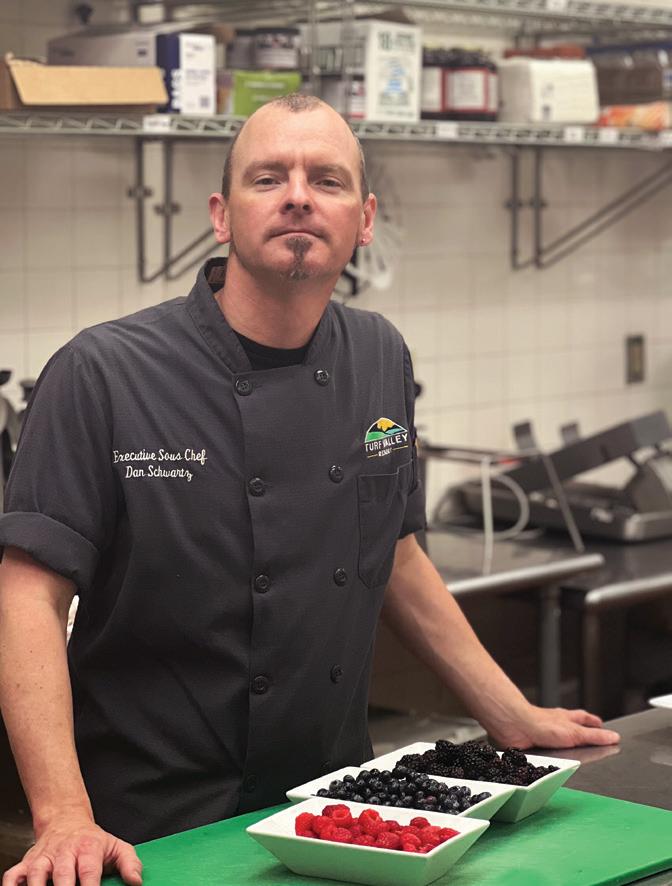
wa es, caprese bites and shrimp casino. O ering a wide variety also allows Schwartz to appeal to those attendees with dietary needs.
“Our goal is always to ensure the highest quality in our food and beverage and preserve the taste and temperature of the item,” he notes.
Even with such attention to detail, chefs must do their best to ensure a smooth event execution and avoid potential setbacks. To have a su cient supply of hors d’oeuvres on hand, Schwartz has devised a simple formula: one passed selection per person, two station items per person and three seafood items per person “because of their popularity,” he says—“for example, our mini crab cakes.”
Schwartz likes to balance passed and stationed options and may add or remove items as needed.
Because no catered event is complete without a memorable finish, Schwartz carries his hors d’oeuvres expertise over to the dessert table. A display of mini Mason jars is filled with cookie dough, lemon bars, cookies and cream, and strawberry shortcake—the makings of a happy ending to any memorable meal. C+RC

www.clubandresortchef.com September 2023 l Club + Resort Chef l 19
Among his sweet and savory displays, Turf Valley Resort Executive Chef Dan Schwartz (left) o ers mini Mason jars lled with cookie dough, lemon bars, cookies and cream, and strawberry shortcake (right).
The Decline of Member Etiquette

Cullasaja Club’s Executive Chef calls for re ection and respect.
By Scott Craig, WCMC, Contributing Editor
AS I STOOD IN the crowded formal dining room of a prestigious club in the Southeast, the chronically overserved member at the table was in the middle of her rant, while her husband absently nodded along. “This isn’t fit to serve a dog,” she said. “Not only that, but I hate the canned chili that you use on hot dogs [we made it from scratch], and everything that you serve is frozen [it wasn’t]. Are you all that short-sta ed in the kitchen?” Many club chefs have experienced this member, and the number of them seems to be multiplying at an alarming rate.
According to Mark Bado, MCM, COO of Mizner Country Club (Delray Beach, Fla.), clubs are facing several challenges, but the most pressing is membership behavior, especially as it relates to a clubs’ ability to maintain sta ng levels.
“It has become awful in nearly all clubs,” he says of the industry. “Entitlement, due in part to rising initiation dues, has led to behavior that disrespects sta members and has even led to physical altercations with fellow members. Many seem to have lost a sense of self-awareness while becoming hyper-aware and critical of their fellow members and sta .”
Country clubs have long been associated with prestige, luxury, and exclusivity. These private enclaves o er their members an escape from the hustle
and bustle of everyday life, providing access to top-notch facilities, recreational activities, and networking opportunities. However, behind the lush landscapes and elegant facades, there is a disturbing undercurrent of poor behavior exhibited by members. This article sheds light on the need for reflection, respect, and a return to the values that once upheld the integrity of these cherished institutions.
BASIC ETIQUETTE
One primary reason for the deterioration of behavior is the diminishing emphasis on etiquette, partly driven by generational change and an acceptance of casual culture. Private clubs exist as microcosms of the larger world, and as our world becomes increasingly casual and polarized by social and political issues, so too do clubs. Traditionally, these establishments have upheld a set of social rules and customs that ensure an atmosphere of decorum and civility. Sadly, many newer members have forgotten—or ignore—these etiquettes Older members, perhaps facing waning influence in their club’s direction or wistful for a previous iteration of their club and the experiences it o ered, participate in this behavior as well.
According to several private club General Managers, examples of
rude behavior across generations have taken many shapes, including loud and boisterous conversations in dining areas, leaving golf carts in inappropriate places, and ignoring dress codes. Such actions not only tarnish the club’s reputation but also impact the overall experience of fellow members. These seemingly innocuous behaviors can evolve if left unchecked, becoming permissive examples.
BREEDING ENTITLEMENT
The exclusivity of country clubs can sometimes, understandably, lead to a sense of entitlement among their members. Those who belong to such elite circles may feel that they are immune to the consequences of their actions. This entitlement can manifest in condescending attitudes toward sta and fellow members, as well as a lack of consideration for shared facilities.
The mistreatment of sta members is concerning. Housekeeping, maintenance, and service sta are essential to the smooth functioning of a club, yet they sometimes endure disrespectful behavior, belittlement, and poor treatment from members. This lack of empathy, which can manifest in overtly punitive behaviors, demonstrates a significant departure from the values of mutual respect and appreciation.
20 l Club + Resort Chef l September 2023 www.clubandresortchef.com
MANAGEMENT
An unnamed and well-respected club manager at a prestigious club in southern Florida recently demonstrated what it looks like when a General Manager stands up to unruly members in support of a department head. When his executive chef faced withering messages from their membership in his first few weeks of employment, the GM addressed the behavior at a Town Hall meeting to abruptly put a stop to the unfounded criticisms.
“Common courtesy is no longer common” he said. “[We must foster] a culture that embraces the men and women who provide services. Leadership requires intestinal fortitude, and as leaders, we must walk the walk. We can’t say that all employees matter [if] our breakroom is located in a closet.”
When asked about the aftermath of his blunt address to the membership, he said that the “silent majority were no longer silent,” as members celebrated the calling-out of problematic peers, and club sta rallied behind the manager.
EXCESSIVE INDULGENCE
The presence of alcohol can exacerbate unruly behavior, disrupting the tranquility clubs o er members. Overindulgence can also lead to incidents of drunk driving, posing serious safety risks. Clubs must take measures to
ensure responsible consumption and enforce strict rules.
A SHIFT IN CLUB CULTURE
Over time, there has been a gradual shift in the culture within some clubs. Instead of fostering an environment of unity, some members have become overly competitive and focused on status, leading to tensions and clashes. According to Bado, examples of this shift include heated arguments over golf scores, inappropriate comments during social events, and instances of snobbery and cliquishness. Such behavior not only alienates fellow members but also undermines the purpose of these clubs as places of relaxation and enjoyment.
A POSSIBLE WAY FORWARD
Clubs have served as esteemed establishments, providing a sanctuary of luxury and relaxation. However, behavior exhibited by some threatens the integrity of these institutions.
As an old friend and well-respected pastry chef once told me, “We’re all here by choice.” According to the Chamber of Commerce, the national quit rate for the hospitality industry has topped 4.9% since July 2021, far greater than the falling national average of 2.6%. Hospitality faced challenges in sta ng well before COVID; increased hostilities toward sta
have exacerbated the issue.
The dressing down that I experienced at the outset of this article was part of my own motivation to seek employment elsewhere. The determining factor in choosing my present, and hopefully permanent, place of employment was based on a healthy culture and sound leadership, a pivot from my prior focus on national ranking and compensation.
My new General Manager, Chris Conner, CCM, of Cullasaja Club (Highlands, N.C.), explains the steps of creating a healthy club culture:
1.Reinforce Etiquette: Prioritize education and reminders on the importance of adhering to etiquette. Seminars and workshops on social decorum can reinforce a club’s values, as well as messaging in town halls and bulletin articles.

2.Zero Tolerance Policy: Implement a zero-tolerance policy for disrespectful behavior toward sta or fellow members. Enforce consequences for breaches of conduct.
3.Alcohol Management: Enact strict rules for alcohol consumption, including mandatory training on responsible drinking and monitoring distribution.
4.Community Building: Promote a sense of community and inclusivity by organizing events that encourage interaction among members, fostering a culture of friendship and mutual respect.
5.Vetting Potential Members:
Having potential members join the club for a trial period, to understand if they are a cultural fit, can bolster the club’s financial position during slow seasons and ensure cultures remain intact.
It’s crucial for members, sta , and management to recognize the gravity of this issue, its impact on sta ng and sustainability, and take proactive steps to address it. By reinforcing etiquette, curbing entitlement, managing alcohol, and promoting a culture of unity, clubs can reclaim their place as beacons of elegance and respect. Only through our collective e orts can these exclusive enclaves continue to be cherished spaces for generations to come. C+RC
www.clubandresortchef.com September 2023 l Club + Resort Chef l 21
How Pelican Isle YACHT CLUB’S GM Leverages Her F&B Experience
Pelican Isle YC’s new Executive Chef, Roger Anderhalden, was chosen by GM Alisha Feezor, who discusses his suitability and anticipated challenges and opportunities.
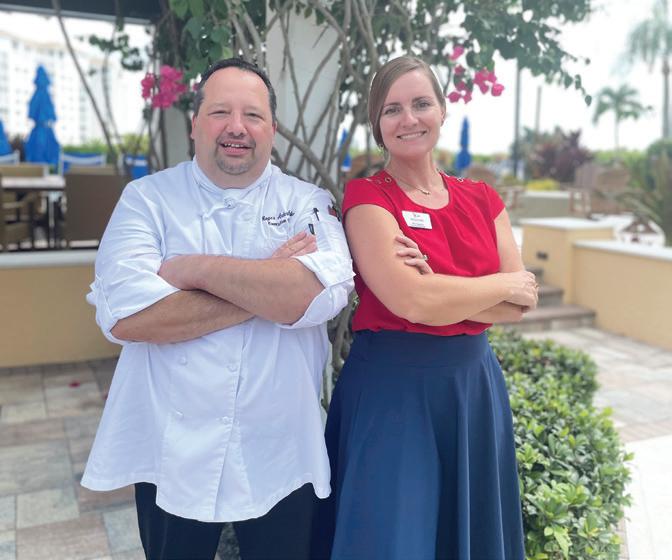 By Isabelle Gustafson, Senior Editor
By Isabelle Gustafson, Senior Editor
AFTER A MONTHS-LONG SEARCH for the perfect candidate, Pelican Isle Yacht Club (Naples, Fla.) hired Roger Anderhalden as its Executive Chef. Anderhalden previously held the position of Executive Chef at The Mediterra Beach Club, also in Southwest Florida.
“[Anderhalden] was a terrific find for us,” says General Manager Alisha Feezor. “Not only did he fit the profile of our ideal candidate, but he was also a pleasure to work with throughout the search and hiring process.”
In addition to his technical skills and culinary background, Feezor adds, Anderhalden possesses strong problem-solving abilities and communication skills—qualities she deems essential in a chef, influenced in part by her own background. Before joining Pelican Isle, Feezor served in the Army for eight years. When she joined the club, she spent four years as Food and Beverage Manager before assuming the role of GM in 2016.
Club + Resort Chef (C+RC): How does your F&B background impact the way you lead as a GM?
Alisha Feezor (AF): It’s helpful to have firsthand experience; it gives credibility with the board, and it has helped me advocate for those departments.
I have an appreciation for the type of support they need, whether it’s equipment, resources, specific communication, guidance. I also have
a good relationship with the [F&B] department heads. The Assistant F&B Director moved up into the department head role. We had a system already in place, so it was a seamless transition.
C+RC: What challenges and opportunities will Chef encounter?
AF: We are still recovering from damages sustained from Hurricane Ian in 2022. In addition to getting to know each of our culinary team members and participating in the planning of our upcoming season, [Chef] will be active in the ongoing capital projects and planning as well as placing high emphasis on creating a great member experience after a very challenging year.
The members are excited and ready to enjoy their club. [Chef] is walking into an environment where everyone is primed for a great experience.
C+RC: You’ve been at Pelican Isle for 10 years. How has F&B evolved?
AF: We’ve made three impactful changes. First, we’ve started using the H-2B program for our seasonal workers, and we are now properly staffed.
Second, we hired an event manager. We do very little outside weddings or corporate events. But even in a smaller operation, you need a dedicated person to spend time on the details for those events so you can deliver a ‘wow’ experience.
Third, like many other clubs, we’ve shifted toward casual dining. We are developing a master facility plan that’ll guide our operation for the next five to 10 years. We’re evaluating ultra-casual dining solutions to continue to meet member expectations in our amenity areas: resort-style pool, bocce courts, tennis, and pickleball.
C+RC: In what other ways do you support the culinary team?
AF: I’m big on making sure they have the tools and the resources they need. I try to spend time back there so I can empathize with their challenges. Sometimes there are little things that are easy to solve—the hot water heater temperature is not set properly or the gasket on the oven is leaking—it just takes the right person to solve it. C+RC
MANAGER to CHEF
22 l Club + Resort Chef l September 2023 www.clubandresortchef.com Visit clubandresortchef.com/pelican-isleyacht-club-hires-executive-chef-rogeranderhalden for the full article.
Pelican Isle YC’s General Manager Alisha Feezor (right) hired Executive Chef Roger Anderhalden (left) to lead the club’s culinary program.
Communication Tool
Product: Relay+ Cellular Walkie-Talkie
Features:
▶ No bigger than a Post-It note
▶ Powered by Wi-Fi and 4G LTE for an unlimited, nationwide range
▶ Sleek and simple push-to-talk design
▶ Communication is fast and in real-time
▶ Compact size and water-resistant parts makes for easier disinfection compared to popular personal-use smartphones that are generally heavy bacteria sources
▶ GPS tracking: See location of distanced workers on a map
▶ Voice assistant: Verbal commands with a press of a button
▶ Cloud-connected deployment: Groups stay connected on mixed channels including the Relay+ device, the online dashboard and smartphone app
▶ Bluetooth connectivity: Integrate with other products and USB-C for both secondary charging and audio output
▶ Extended battery life: Full charge can last up to two days
▶ Screen-free: Eyes-up control for workers on the go keeping a 6-foot distance
Relay
www.relaygo.com
Clocks
Marking Time
Product: Golf Course Clocks by The Verdin Company


Features:
▶ Enhance the beauty of your course
▶ Choose from many 4- and 2-faced models
▶ Customizable colors, dials, logo, name panels, and fonts
▶ Superior Moonglow® backlit dials are shatterproof
The Verdin Company
800-543-0488
www.verdin.com
Your Name, Please?
Product: FlxRez Reservation System
Features:
▶ Reservation systems for all areas of the club
▶ Aquatics/pool
▶ Fitness centers
▶ Driving ranges
▶ Golf simulators
▶ Spas and barber shops
▶ Tennis, pickleball, handball, bocce, etc.
▶ Gyms and basketball
▶ Trap and skeet ranges
▶ Electronic scorecards (mobile app)
ForeTees www.foretees.com

Kitchen Equipment
Fire It Up
Product: Wood-Fired Mobile Oven
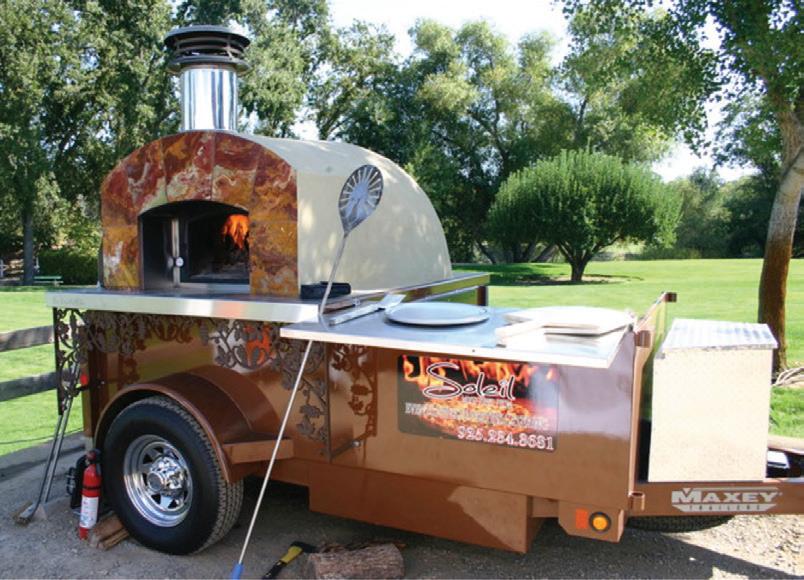
Features:
▶ Capitalize on a trend that has captured the hearts and taste buds of America – wood fired cooking
▶ Ideal for all types of dishes such as cedar plank salmon, smoked trout, roasted vegetables and perennial favorite, wood fired pizza
▶ Live-fire cooking offers the perfect blend of oldworld romance and mouth-watering cuisine
▶ Stand out from other resorts and clubs with a custom-branded, mosaic-tiled mobile oven
▶ Can be set up on the beach, in a picnic area, on the 18th fairway, even poolside
▶ Comes with a small price tag (less than $15k) while delivering significant ROI
▶ Wood-fired cooking can drive bookings for all types of events and get-togethers
Fire Within www.firewithin.com
www.clubandresortchef.com September 2023 l Club + Resort Chef l 23
PRODUCT SHOWCASE
Technology
F��� + B�������
Delicious Dinner
Product: Redpack® Marinara and Spaghetti Sauce Pouches
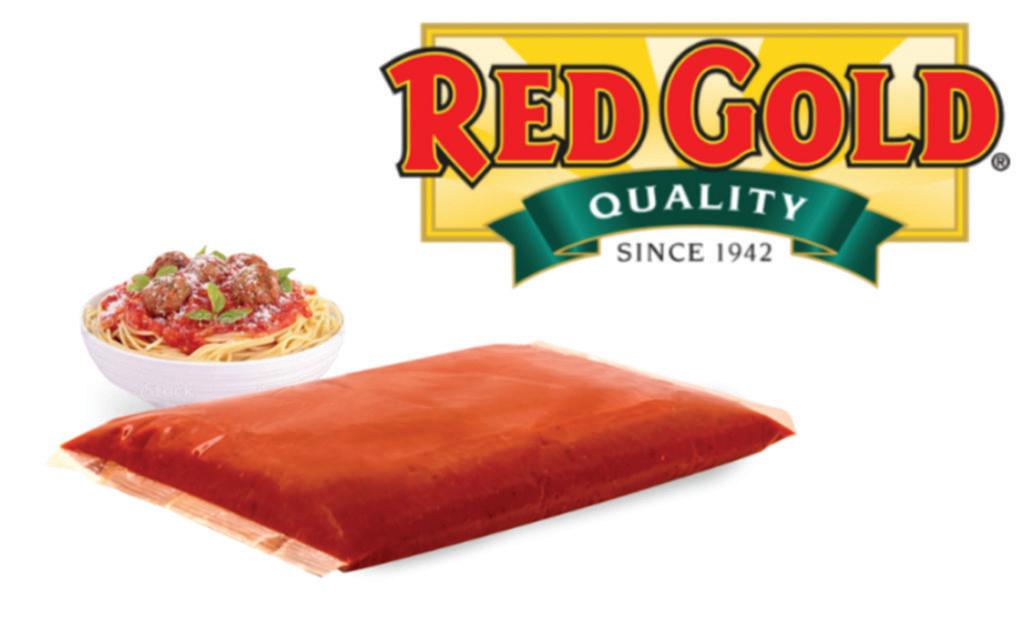
Features:
▶ Why pay more for a can?
▶ Affordable 105 oz. pouches
▶ Same exceptional quality sauce made with Italian spices, pieces of tomatoes and oil
▶ Available in 6/105 oz. cases
▶ Ask your distributor for Redpack Marinara and Spaghetti Pouches today
Red Gold


www.RedGoldFoodservice.com
Savory Sausage
Product: Bias Sliced Italian Sausage (30 lb. Case)
Features:
▶ Fully cooked
▶ Premium, skinless, coarsely ground pork sausage
▶ Traditionally seasoned with unmistakable Mediterranean spices
▶ Already browned
▶ Flame-grilled for superior flavor
▶ Cut into ¼-inch bias slices for use as an ingredient in entrées, salads, soups, pasta dishes and more
▶ Heat and serve
▶ No MSG
▶ Gluten Free Johnsonville Foodservice
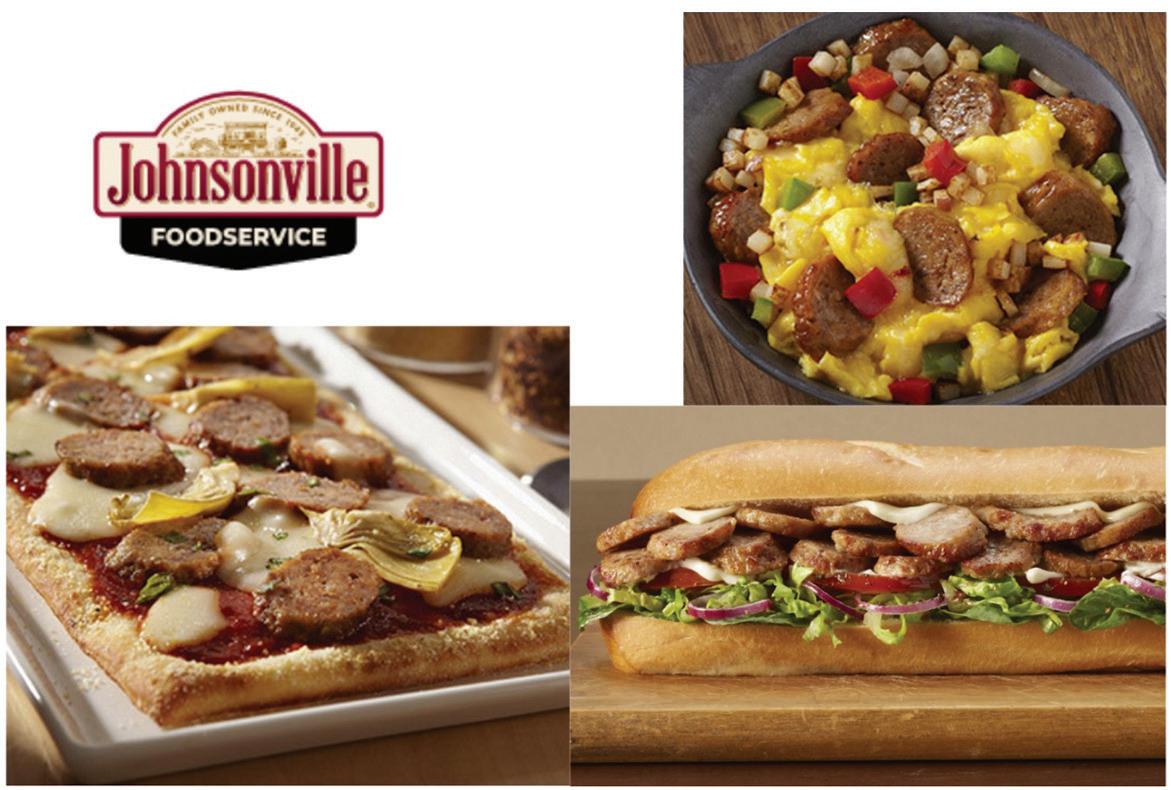
www.johnsonvillefoodservice.com








Snack Time
Product: Hubs Extra-Large Virginia Peanuts
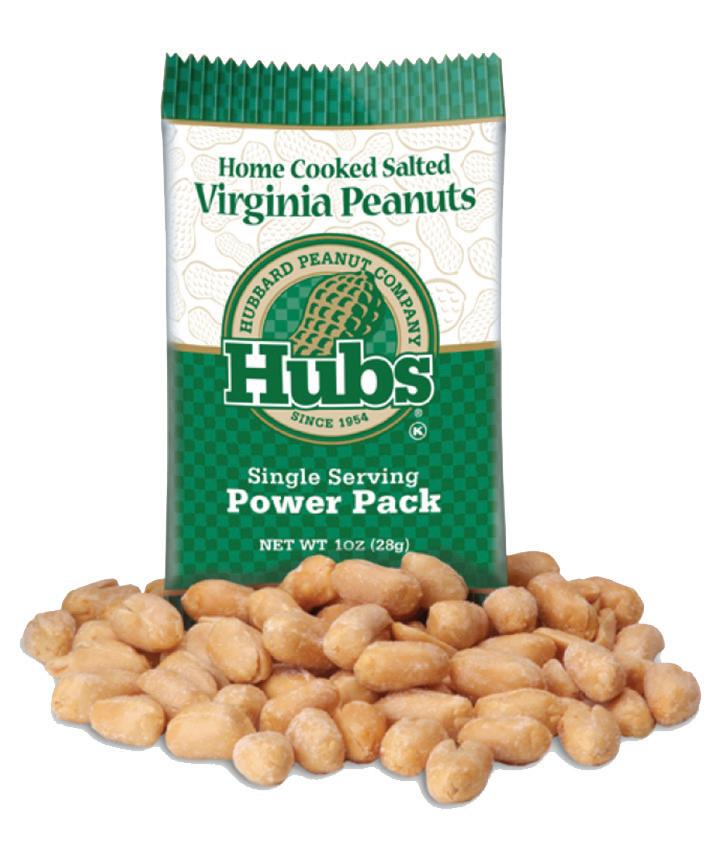
Features: next order
Artisanal, home-cooked, delicious snack 1 oz., 3 oz., or 5 lb. vacuum sealed bags Available salted or unsalted
Ask for a free sample and we'll send it with your
Duffy’s Tri-C Club Supply www.DuffysTriC.com
24 l Club + Resort Chef l September 2023 www.clubandresortchef.com PRODUCT
CORBY HALL 3 www.corbyhall.com THE MONTAGUE COMPANY 26 800-345-1830 / www.montaguecompany.com NORTH COUNTRY SMOKEHOUSE 13 NCSmokehouse.com RATIONAL 15 www.rationalusa.com RED GOLD 5 RedGoldFoodservice.com/sample-requests SALSBURY INDUSTRIES 7 800-Lockers / www.lockers.com SOUTHERN PRIDE 25 www.southernpride.com ADVERTISER INDEX
SHOWCASE
DESIGNATED SMOKING AREA







Being a third generation, family-owned and operated business is something we take seriously. We are proud to offer a full line of Electric, Gas or Mobile lines of equipment to fit your individual needs. Our equipment is designed with the highest quality materials and components ensuring a long life, giving you unmatched performance with every use. The ease of use with any Southern Pride and the consistent heat are just a few of the reasons we’ve been able to build the customer base we have today. We proudly offer a network of distributors making your partnership with Southern Pride easy and rewarding. Visit us online at southernpride.com today!




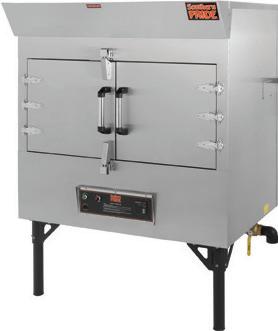






MADE WITH PRIDE IN THE USA

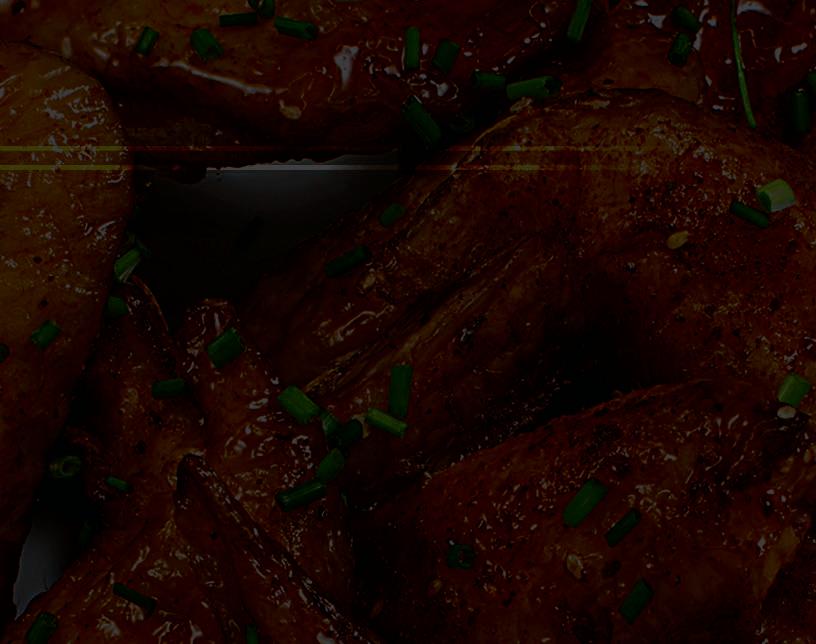



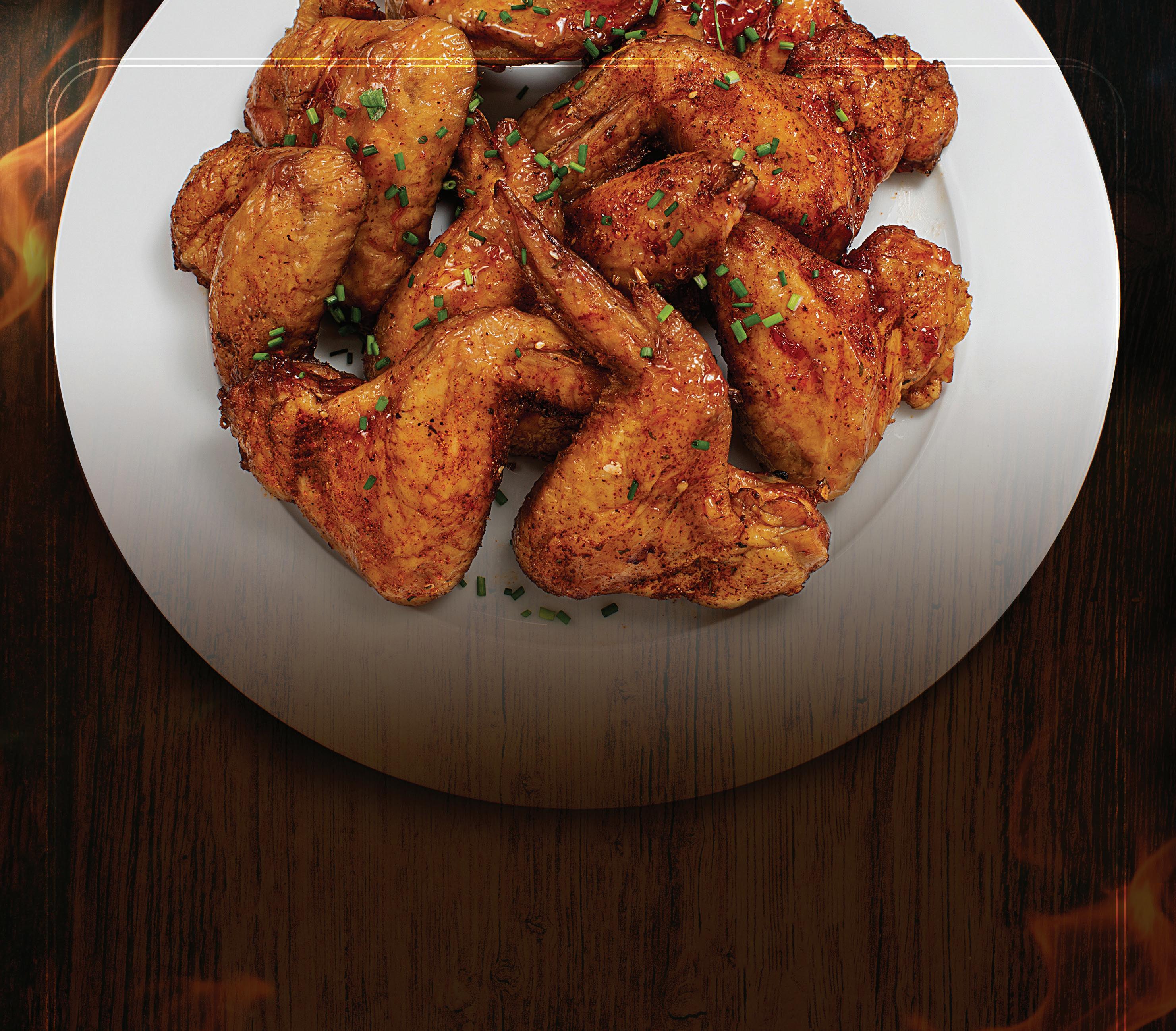
Alamo, Tennessee | southernpride.com
Optional


42,000 BTU cast iron burners deliver powerful infrared heat as high as 1800°F Adjustable broiler drawer with positive locking counterbalanced grid assembly


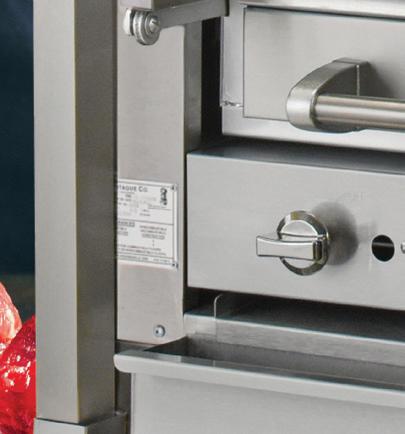


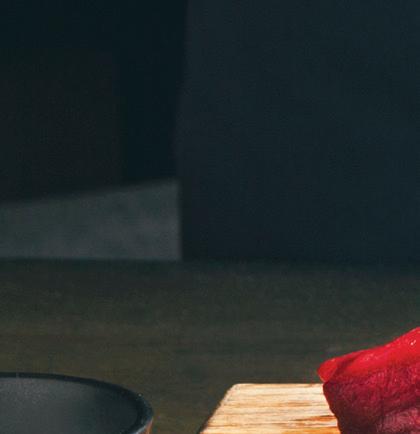
Independent burner controls – 36” models feature two; 45” feature three
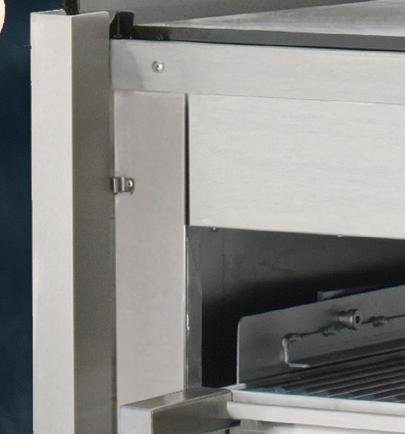

Multiple configurations:




• Warming ovens, top or bottom


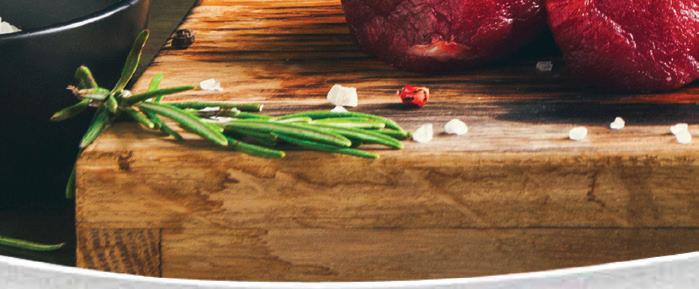
• Refrigerated cabinet base






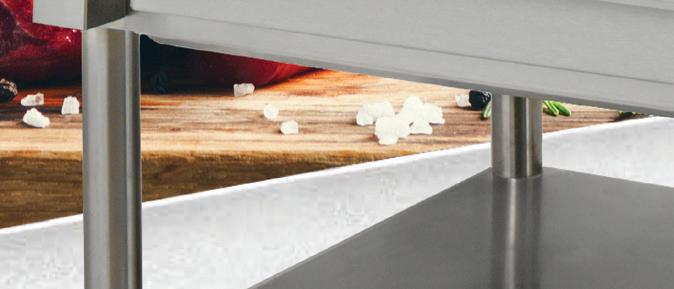
• 36” and 45” widths
• Single and double broilers





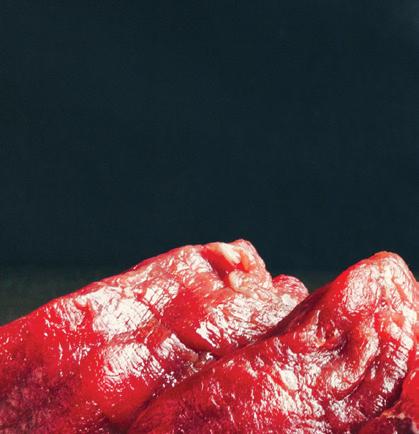




MADE IN USA The Montague Company • 1-800-345-1830 • montaguecompany.com
Cooking Innovation. Done to Perfection.
Steakhouse Broiler offers chefs powerful, high-volume, heavyduty broiling, producing tender, flavorful entrees customers will rave about.
that’s perfection.
time to discover Montague! steakhouse broiler ®
Manufactured in the United States by skilled craftsmen, the Montague Legend®
Now
It’s
1/2” Sear Plate or 3/4” Plancha, seals in juices before broiling























 Joanna DeChellis jdechellis@wtwhmedia.com 412-260-9233
Joanna DeChellis jdechellis@wtwhmedia.com 412-260-9233































































































































































 By Isabelle Gustafson, Senior Editor
By Isabelle Gustafson, Senior Editor































































